Text
CULIBRA ECHEVERIA: CARE GUIDE AND PROPAGATION TIPS / Its About Gardening

Culibra Echeveria also called "Culebra Echeveria" is understood for having rosettes that can grow up to 7 (7) inches in diameter. Culibra Echeveria has light blue color and also pink and also waxy ideas. Each fallen leave has a supposed "caruncle" on the upper part, which causes the leaf to curl or bend downwards at the ends, which causes tubular fallen leaves.
Culibra Echeveria belongs to the genus of Echeveria, which is understood for having one hundred and fifty (150) varieties of succulent plants. Additionally, Echeveria is under the family of Crassulaceae, a stonecrop household with over one thousand (1,000) species of seasonal natural herbs or reduced bushes. Adding this type of Echeveria in a garden will definitely give an additional individuality and elegance.

Culibra Echeveria Care Guide
In preparing to grow a succulent like Culibra Echeveria, it is essential to recognize exactly how to care for the succulents effectively. Hence, the guides below will surely help.
How to water Culibra Echeveria?
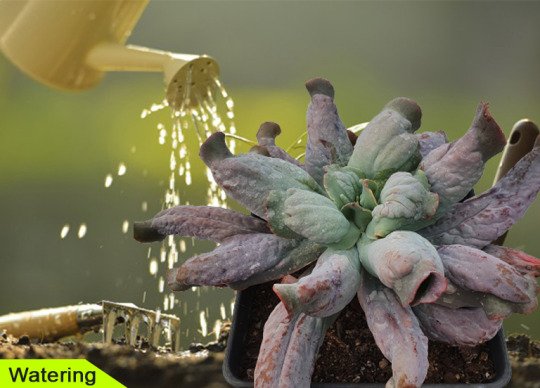
Understanding the proper method of sprinkling a plant is just one of the critical things that a garden enthusiast ought to recognize. When watering the Culibra, do not put water on its foliage due to the fact that it may bring about decomposing of the fallen leaves or contaminate the leaves with fungi. If this happened, right away eliminate the afflicted fallen leaves making use of a knife to stop damage on the whole Echeveria.
Making use of a water bottle in sprinkling the Culibra Echeveria is advised. Put water on the dirt and also see to it that it will certainly reach the Culibra's origins. Water the Culibra just if the soil dries out and also doesn't water it daily as it might trigger the roots to rot as a result of overwatering. The estimated days before the land obtains completely dry is seven (7) to 10 (10) days, however it always depends upon the environment and also period.
What lighting condition does Culibra Echeveria prefer?

The Culibra Echeveria favors intense light as various other succulents do. You can plant this succulent inside or outdoors; regardless will do as long as the Culibra can obtain enough sunlight, it will certainly live.
However, growing Culibra Echeveria out is the better one to do since it can obtain enough sunshine and great air circulation outside than within. It is essential to stay clear of putting the Echeveria in direct sunshine as it may cause sunburn, which is not ideal for this succulent.
Sunburn mainly takes place during the summertime season, where the sunlight is intense. During this season, the sunlight exposure of Culibra must be at the very least 2 hrs every day just to prevent too much sunning the foliage.
What temperature is needed for the Culibra Echeveria to survive?

The ideal temperature for most echeverias in the daytime is 70 degrees F and also in the evening time is 40-60 F. The Culibra can not endure a soil temperature level that is above 100 F or below 32 F, as the Culibra chooses to cool off in the evening.
How does the Culibra Echeveria look like during the different seasons?

During autumn, Culibra Echeverias attains its maturity and ideal color. In spring, the Culibra looks great as it obtains fresh new growth. In winter, this succulent is not in its best look as it goes inactive and also has dry fallen leaves on its base.
Throughout the summer season, the Culibra Echeveria's fallen leaves may be breakable and look weak; consequently, it requires thorough care throughout this moment.
Can a fertilizer be used in growing Culibra Echeveria?

The Culibra Echeveria does not call for fertilizer. However, you can apply a weak fertilizer at the start of the growing season, throughout springtime or summer season.
How to remove bugs and insects?

The Culibra, much like various other Echeverias, is prone to mealy pests that strike its fallen leaves. Using alcohol with 70% option is one method to eliminate such bugs. Utilize a brush as well as dip it in alcohol, after that thoroughly apply it to the Culibra leaves. When leaves get infected by microorganisms brought on by bugs and other insects' microorganisms, eliminate them to make sure that the whole succulent will certainly not obtain impacted.
How to Propagate Culibra Echeveria?
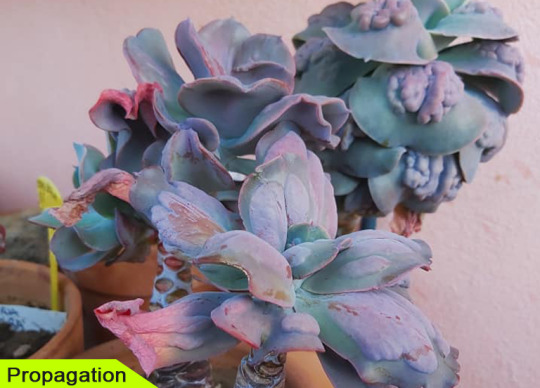
Propagating Culibra Echeveria can be done by seeds or by offsets. Below are details on just how to recreate Culibra Echeveria.
● Propagating Culibra Echeveria by seeds-- When using this method, it is crucial to consider the seed high quality to expand good Culibra Echeveria. It would aid if you used a seed tray for developing Culibra seeds as it is shallow and has lots of drainages. Afterward, placed a soil, ideally a mix of mud, grit, as well as perlite, after that spray it with water to dampen the soil. Then, carefully scatter the seeds; note that it needs to be covered with soil mix, after that placed a plastic cover or a wrap over the seed tray. Area the tray in a cozy as well as bright area or place and also guarantee that the humidity stays high. Remember that succulents can not deal with a freezing temperature level. Then wait on the Culibra's seeds to grow and grow a little prior to growing them individually on different pots.
● Propagating Culibra Echeveria by offsets-- You can additionally reproduce the Culibra Echeveria with offsets. Once the Culibra currently produced an baby plant, carefully eliminate the baby plant without hurting the primary Culibra. Tidy the origins by removing the soil attached to them. Prepare a pot with the selected soil mix; the tool must be moist, meticulously plant the offset. Water the plant once the soil dries.
The Culibra Echeveria is recognized for having distinct as well as charming rosettes because of the caruncles on its fallen leaves that are absolutely eye-catching. The beauty of this succulent will certainly attract any person who sees it. It only needs treatment from its proprietor then it will prosper for long.
So, if you are brand-new to succulents and also planning to grow one, ensure to put in effort to develop a Culibra Echeveria since doing so will definitely help the plant. It will be a terrific concept to consider as well as adhere to the treatment guide and the propagation tips above in growing your Culibra Echeveria. Keep in mind that caring for a succulent will certainly not be challenging, yet it will certainly be a fun and also exciting experience.
#How to water Culibra Echeveria#What lighting condition does Culibra Echeveria prefer#What temperature is needed for the Culibra Echeveria to survive#How does the Culibra Echeveria look like during the different seasons#Can a fertilizer be used in growing Culibra Echeveria#How to remove bugs and insects#How to Propagate Culibra Echeveria
1 note
·
View note
Text
CRASSULA TIGER JADE SUCCULENT CARE GUIDE / Its About Gardening

Crassula Tiger Jade is an appealing, dwarf short-lived or seasonal succulent that has a small growth practice. It has various stems that form tufts from an upright woody rootstock.
Its beautiful fallen leaves are slim, approximately 1 inch long, organized in a spiral pattern creating rosettes. It is pale to dark eco-friendly with scattered purplish to red or black areas and purple bottoms with unshaven developing put up stem.
This succulent produces tiny pink as well as white flowers from summer season via late fall.
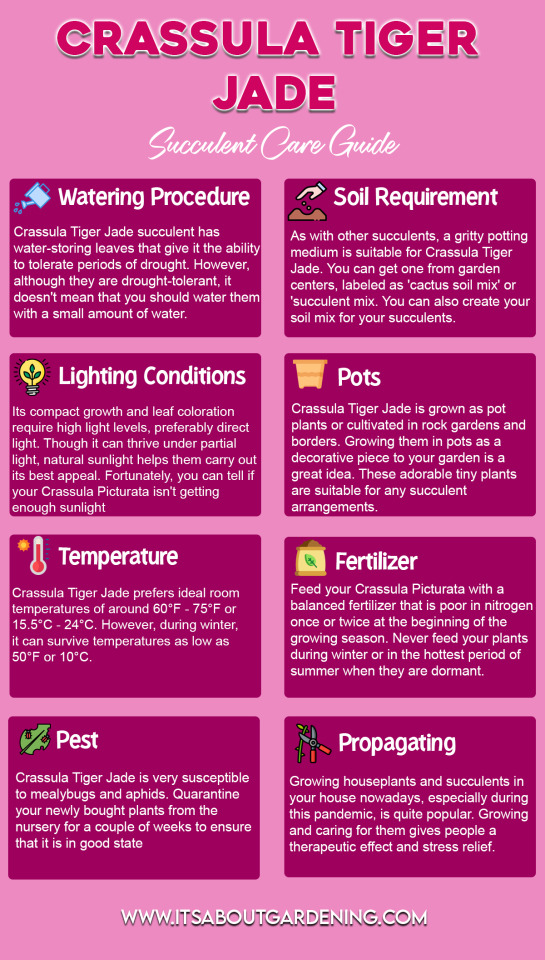
Crassula Tiger Jade Care Guide
Crassula Picturata succulents are very easy to grow as with various other Crassula varieties. They can be expanded both indoors as well as outdoors. However, some succulents pass away when expanded inside your home as a result of insufficient sunlight and also lack of proper ventilation.
If you desire your Crassula tiger Jade to thrive indoors, you need to simulate their suitable exterior environment as high as possible. Supply them ample sunshine by placing them on your windowsill or under a grow light or synthetic light to guarantee they obtain enough sunlight. Also, appropriate air flow is another variable to think about when developing your succulents inside your home.
Growing succulents in your garden expected to provide you favorable results on mental health and wellness; you ought to never be stressed out when taking care of them. List down below are the health care guides on just how to grow your succulents healthy.
Watering Procedure

Crassula Tiger Jade succulent has water-storing leaves that give it the capacity to tolerate periods of dry spell. However, although they are drought-tolerant, it does not suggest that you ought to water them with a small amount of water.
When watering your Crassula Tiger Jade, it is best to saturate the soil and afterwards permit it to dry out entirely before watering again. Similar to other succulents, overwatering is deadly to your plant. Constantly check the dirt mix of your plant before watering, specifically the ones inside. The soil of your plant indoors is more probable not to dry quicker than the plants outdoors.
Water your Tiger Jade consistently throughout summer season via early winter season or in completely dry durations, however water reasonably when dormant. Tiger Jade dormancy takes place during fall and also winter months. Throughout winter, as the temperature gets reduced, minimize the frequency of watering. Base watering is useful during this period.
Base watering is by putting water right into home plates of your container. Allow your plant to take in dampness from home plate for 5 to 10 mins, depending on the size of the container. Then, make certain to remove the excess water from the plate.
Soil Requirement
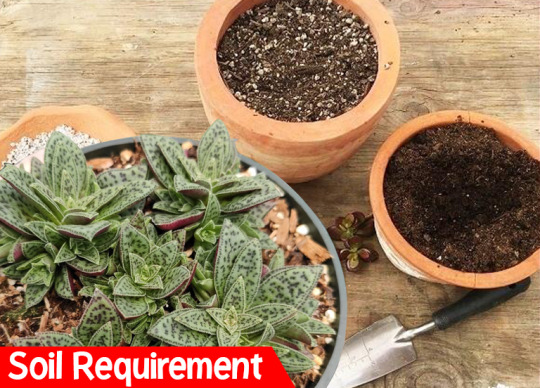
As with other succulents, a sandy potting tool appropriates for Crassula Tiger Jade You can get one from yard facilities, labeled as 'cactus soil mix' or 'succulent mix. You can also develop your soil mix for your succulents.
Producing a soil mix for your succulent is incredibly very easy. Initially, prepare 1 part of routine potting soil and also two parts of rugged sand or perlite, after that unload everything into a container as well as mix it all.
This type of mix allows water to drain pipes because, as we know, succulents do not such as to being in wetness for very long. It additionally gives proper aeration to the origins of your plants. Without adequate aeration creates the origins rot due to waterlogging.
Lighting Conditions for Crassula Tiger Jade

The Crassula genus is in the Crassulaceae family members, which generally endures a large range of light degrees. Jade Plant Kingdoms like Crassula Picturata take pleasure in a sunny setting in the yard throughout summer.
Its small development and also fallen leave coloration require high light degrees, ideally direct light. Though it can grow under partial light, all-natural sunshine helps them perform its best appeal. Thankfully, you can tell if your Crassula Picturata isn't getting enough sunshine. They begin to stretch out, come to be pale in shade, as well as shed their small form.
Appropriate sunshine is also essential to the progressing procedure of Crassula Picturata Succulents. Therefore, they will not generate flowers without sunlight.
On the other hand, intense sunshine and also extreme warm might shed Tiger Jade's fallen leaves as well as stems, specifically throughout summertime and also if you live in warmer regions.
Pots

Crassula Tiger Jade is grown as pot plants or grown in rock gardens and also borders. Growing them in pots as an attractive piece to your yard is a fantastic suggestion. These adorable tiny plants appropriate for any type of delicious arrangements.
In expanding this succulent, containers with excellent drain are important as these kinds of plants are very vulnerable to root rot.
As specified above, Tiger Jade has an upright woody rootstock, which is why you require a much deeper container. Terracotta and the ceramic pot are the perfect containers for solid as well as heavy material because this plant is popular as top-heavy plants. It can prevent the plant from toppling.
When your Crassula Tiger Jade ends up being origin bound, transplant it in a larger pot to add and also renew the soil. However, if you like it to be in a smaller container, you can constantly divide it into numerous plants.
Temperature

Crassula Tiger Jade prefers suitable area temperatures of about 60 ° F-- 75 ° F or 15.5 ° C-- 24 ° C. However, throughout winter, it can make it through temperatures as low as 50 ° F or 10 ° C.
Fertilizer
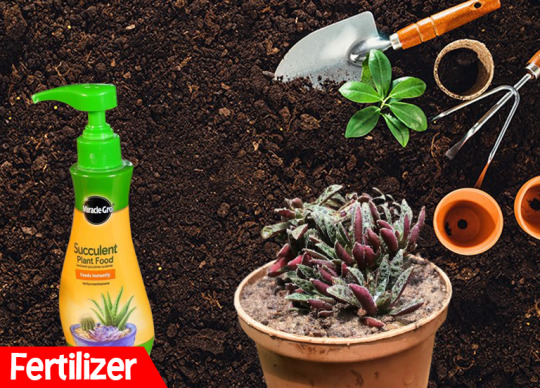
If you intend to raise your Crassula Picturata, give them a slow-release fertilizer annually.
Feed your Crassula Picturata with a well balanced fertilizer that is poor in nitrogen one or two times at the beginning of the expanding season. Never ever feed your plants throughout winter months or in the best period of summer when they are dormant.
Crassula Tiger Jade Pests

Crassula Tiger Jade is very susceptible to mealybugs and aphids. Quarantine your newly bought plants from the nursery for a couple of weeks to ensure that it is in good state
Mealybugs are tiny, white soft-bodied bugs. These bugs produced a powdery, waxy layer which gives them a fuzzy look. They are very hard to get rid of because of their size. However, if you notice the presence of those tiny bugs, brush it off with a small paintbrush dipped in rubbing alcohol and pick off all the bugs and cotton nests that you can find.
Aphids also are tiny sap-sucking pests. To do away with aphids normally, make a homemade spray made from soapdish and also water. After that, spray straight onto the stems and foliage of your ravaged Crassula Tiger Jade.
Propagating Crassula Tiger Jade
Growing houseplants and succulents in your house nowadays, particularly throughout this pandemic, is quite prominent. Expanding as well as taking care of them provides individuals a restorative impact as well as stress and anxiety alleviation.
Plant propagation is a delightful task to grow your collection of stunning plants. It is additionally cost-efficient if you are planning to increase a multitude of plants in your garden.
Crassula Tiger Jade has Numerous approaches of propagating: Division, Offsets, Fallen leave cuttings, as well as Stem cuttings.
Root Division
If your Crassula Tiger Jade outgrew its pot, it is best to divide the plant. Prior to performing this approach:
1. Make sure that the soil of your plant is dry.
2. Dig out the whole plant from its pot, then carefully divide the roots.
3. Plant the first half back to its original container, then plant the other half into a new container.
Through Offsets
Succulent offsets, also known as chicks or pups, are the small rosettes found at the mother plant’s base. If your mother plant produced an offset, it is an indication that your plant is doing well.
It would help if you did the propagation through offsets during spring. First, cut the offsets with a clean knife or cutter, then dry for a week or less. Be sure to keep them in a shady area. If you notice the cut part is already dry, it is time to plant it in a new container. Do not water it for a week. After a few weeks, it will start to develop new roots.
Through Stem Cuttings
Same in offset propagation, you should do the stem cutting propagation during spring. Cut 2-3 inch stem from the mother plant and let the cut dry for a couple of days. Keep the cut stem away from direct sunlight.
For a better result of propagation, you can dip your cut stem into the rooting hormone. But if you don’t have a rooting hormone, you can plant it into a new pot with proper drainage.
Same as the process in offset propagation, do not water your new plant for a week. take note: Do not put your new plant under direct sunlight.
Through Leaf Cuttings
When repotting your Crassula Picturata, some leaves of your plant may fell off the ground. Pick those leaves up from the ground and use them to propagate new plants.
Propagation through leaf cuttings needs lots of patience. It takes several months for a bare leaf to become a young plant. But the fulfillment that it gives is undeniable.
Select healthy leaves to propagate and toss them onto a clean, dry tray. Place the tray under the bright and shady part of your garden. After a few weeks, hair-like roots and baby rosettes will appear. Plant your new plant when the mother leaf is starting to dry up.
#Crassula Tiger Jade Care Guide#Watering Procedure#Soil Requirement#Lighting Conditions for Crassula Tiger Jade#pots#Temperature#Fertilizer#Crassula Tiger Jade Pests#Propagating Crassula Tiger Jade
0 notes
Text
BLACK PRINCE ECHEVERIA DISEASES, CAUSES, AND SOLUTION / Its About Gardening

Black Prince Echeveria is a distinctive succulent that is slow-growing and also has special attributes. It has dark purple rosettes that seem black in color as well as triangular fit with yellow ideas. In late fall or early winter months, this beautiful plant generates dark red flowers. However, no matter how charming a succulent is, it is not exempted from illness triggered by numerous problems.
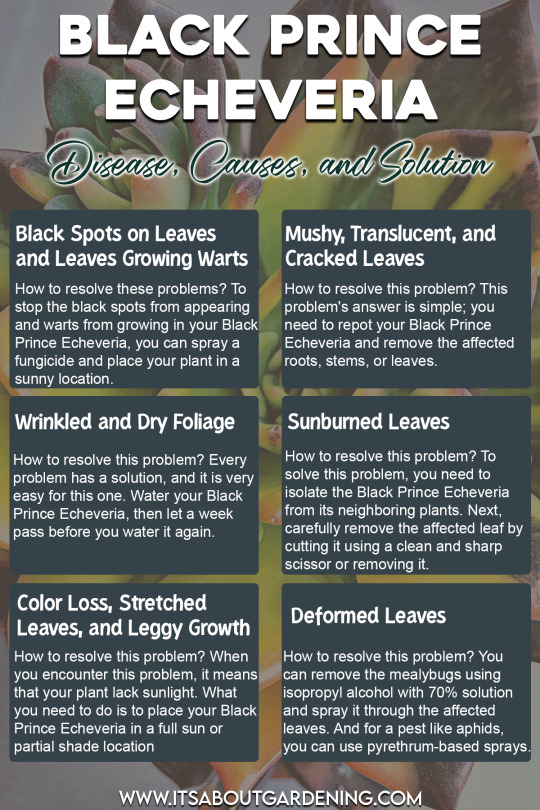
Below are a few of the conditions, triggers, as well as services that a Black Royal prince Echeveria can obtain.
Common Diseases of Black Prince Echeveria, Causes, and Solutions
1. Black Spots on Leaves and Leaves Growing Warts
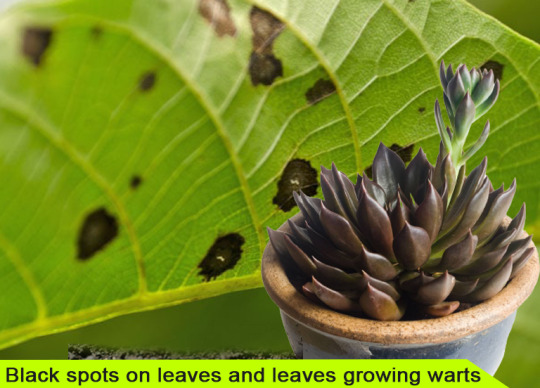
Black Prince Echeveria, like many succulents, are prone to conditions like having black marks and boosting moles of their leaves. The black places on the Black Prince Echeveria's leaves arise from a fungal infection due to way too much water. Though succulents are recognized for having issues on their fallen leaves that store water, it is still wrong to put way too much water on them. Also, because of too much water and also high humidity, verrucas tend to expand on the Black Prince Echeveria's fallen leaves. Warts normally show up when the Black Prince Echeveria was excluded in the rain for consecutive days without the leaves' possibility to dries.
SOLUTION: Just how to deal with these troubles? To stop the black spots from showing up and growths from growing in your Black Prince Echeveria, you can spray a fungicide and also place your plant in a bright place where it can have the opportunity to dry its fallen leaves and origins. Likewise, never let your delicious soak in the rainfall for greater than 2 days. If it is the stormy season, bring your Black Prince Echeveria to a greenhouse as well as maintain it warm.
2. Mushy, Translucent, and Cracked Leaves

Having mushy and translucent fallen leaves is one of the most typical issues Black Prince Echeveria can obtain, as well as this trouble is caused by overwatering. Succulents are really sensitive when it pertains to the water they need, therefore is Black Prince Echeveria. This plant can not soak up water quickly, so it dislikes to have excessive water in its soil and leaves. You can see that overwatered Black Prince Echeveria looks mushy and translucent, and sometimes, its foliage also fractures.
SOLUTION: Exactly how to settle this issue? This issue's response is basic; you require to repot your Black Prince Echeveria as well as remove the affected origins, stems, or leaves. It would certainly be best to see to it that the pot you will use has enough drainage openings. A well-draining dirt is needed as well. Prior to growing your Black Prince Echeveria, air-dry it for a couple of days. See to it never to make the very same error once again and take good care of your plant. You can likewise learn the correct watering techniques to grow your Black Prince Echeveria better.
3. Wrinkled and Dry Foliage

Underwatering is the leading reason why the Black Prince Echeveria has wrinkled and also completely dry fallen leaves. Certainly, overwatering is not appropriate for succulents, but so is underwatering. Remember that the majority of plants on this earth, whatever species, require water. An old and wrinkly and also dry Black Prince Echeveria looks lifeless and also is not pleasing in the eyes. Underwatering might also cause succulent's death, which every gardener avoids.
SOLUTION: How to settle this issue? Every problem has an option, and it is very simple for this one. Water your Black Prince Echeveria, after that let a week pass before you sprinkle it again. Comply with the "soak and completely dry approach" after a week, and you will see that your Black Prince Echeveria is slowly going back to the method it looks. Never ever undersea your succulent once more, as well as make sure it gets sufficient water it requires to flourish.
4. Sunburned Leaves
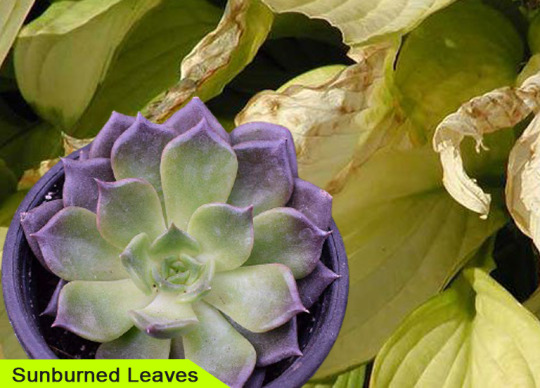
Believe it or otherwise, sunburn can also occur to Black Prince Echeveria. The factor for this trouble is primarily due to excessive straight sun exposure. This plant requires sunlight to live, yet placing it in straight sunlight is not an excellent idea. That is why it is suggested to place Black Prince Echeveria in a bright place approximately partial color with optimum hrs of 6 because leaving your plant in straight sunlight for also long will only create sunburn on its fallen leaves.
SOLUTION: Just how to solve this problem? To address this problem, you require to isolate the Black Prince Echeveria from its neighboring plants. Next off, thoroughly remove the afflicted leaf by cutting it making use of a clean and sharp scissor or removing it in a twisting activity until it separates from the stem. Make certain that you remove the whole part of that leaf and left none on the stem. Doing this will certainly stop the entire plant from being affected by the sunburnt fallen leave.
5. Color Loss, Stretched Leaves, and Leggy Growth
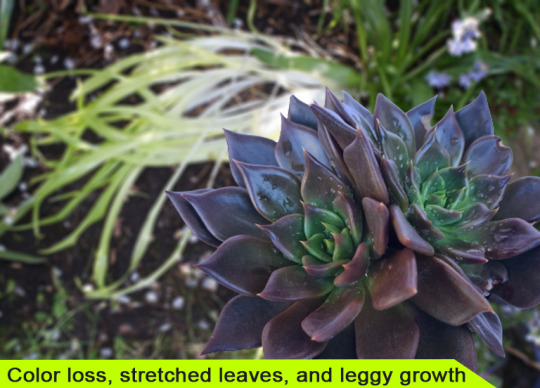
Issues such as color loss stretched leaves, and also an absence of sun exposure triggers leggy growth. Many echeverias need at least 5 to 6 hours of sunlight direct exposure. If your Black Prince Echeveria does not obtain sufficient sunlight, these problems could take place. Consequently, expanding Black Prince Echeveria is advisable to be outdoors as opposed to indoors because it additionally chooses ventilated rooms. It is needed to recognize that sunshine is an important part of growing a Black Prince Echeveria. Without sun exposure, it might be difficult for the Black Prince Echeveria to make it through. However in times of cool as well as rainy weather, it is much better to maintain them inside as well as maintain them cozy.
SOLUTION: Just how to settle this trouble? When you experience this issue, it indicates that your plant absence sunlight. What you need to do is to place your Black Prince Echeveria in a complete sunlight or partial color place where it can obtain enough sunlight exposure and also leave it there for 5 hours each day. But do not let it be under straight sunshine for too long, or else it might trigger sunburn to its vegetation.
6. Deformed Leaves

Pests like mealybugs and also aphids are the leading reason why Black Prince Echeveria has actually warped fallen leaves. Mealybugs are tiny and also oval-shaped insects with a powdery white wax covering. When you take a look at them on plants, they appear to be little areas of cotton. They love to assault succulents like Black Prince Echeveria. Aphids, on the other hand, are little bugs that transmit infections amongst plants. These two insects are the primary enemies of Black Prince Echeveria. When these two little pests feed upon Black Prince Echeveria's fallen leaves, they will certainly leave a little mark as well as a sticky liquid waste called "honeydew"; a fungi will certainly expand on this honeydew, later on, transform black. The influenced fallen leave will deform as it grows.
SOLUTION: Just how to resolve this issue? You can eliminate the mealybugs utilizing isopropyl alcohol with 70% remedy as well as spray it via the affected leaves. As well as for a bug like aphids, you can utilize pyrethrum-based sprays. However bear in mind that you can not kill the issues swiftly. These bugs are relentless and will certainly maintain pertaining to your Black Prince Echeveria, so you need to frequently check your succulent and do the essential action to avoid infections from coming back to your Black Prince Echeveria.
It lacks an uncertainty that a Black Prince Echeveria is an excellent succulent to expand. However you also need to watch as well as provide added care to your lovely Black Prince Echeveria due to the fact that numerous illness can come as well as harm your succulent. The information above will surely offer you the necessary details you need to find out about Black Prince Echeveria diseases and causes. Remember that Black Prince Echeveria will certainly expand magnificently when disease-free.
#Black Spots on Leaves and Leaves Growing Warts#Mushy#Translucent#and Cracked Leaves#Wrinkled and Dry Foliage#Sunburned Leaves#Color Loss#Stretched Leaves#and Leggy Growth#Deformed Leaves
1 note
·
View note
Text
AEONIUM SUNCUP CARE GUIDE AND PROPAGATION TIPS / Its About Gardening
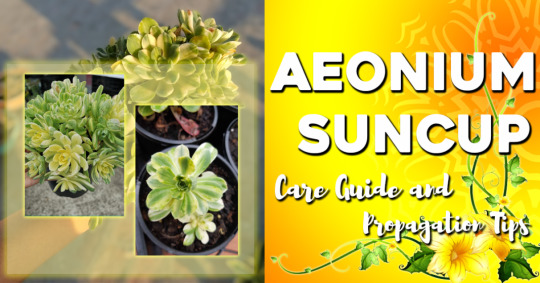
Aeonium Suncup, likewise called Aeonium Castelo-Paivae Variegata Suncup, is a tiny succulent ideal and also suitable for adorable pots or containers.
When it reaches its maturation growth, it reaches up to 30 cm high and about the same diameter. Its leaves are mainly in cream, green, and also pale yellow variegation with glowing pink margins.
It generates a pretty white flower on the rosette's facility that you will undoubtedly love to witness throughout winter.
Aeonium Suncup is native to Canary Islands, Africa, and also just like various other succulents, it favors brilliant light as well as excellent drainage.
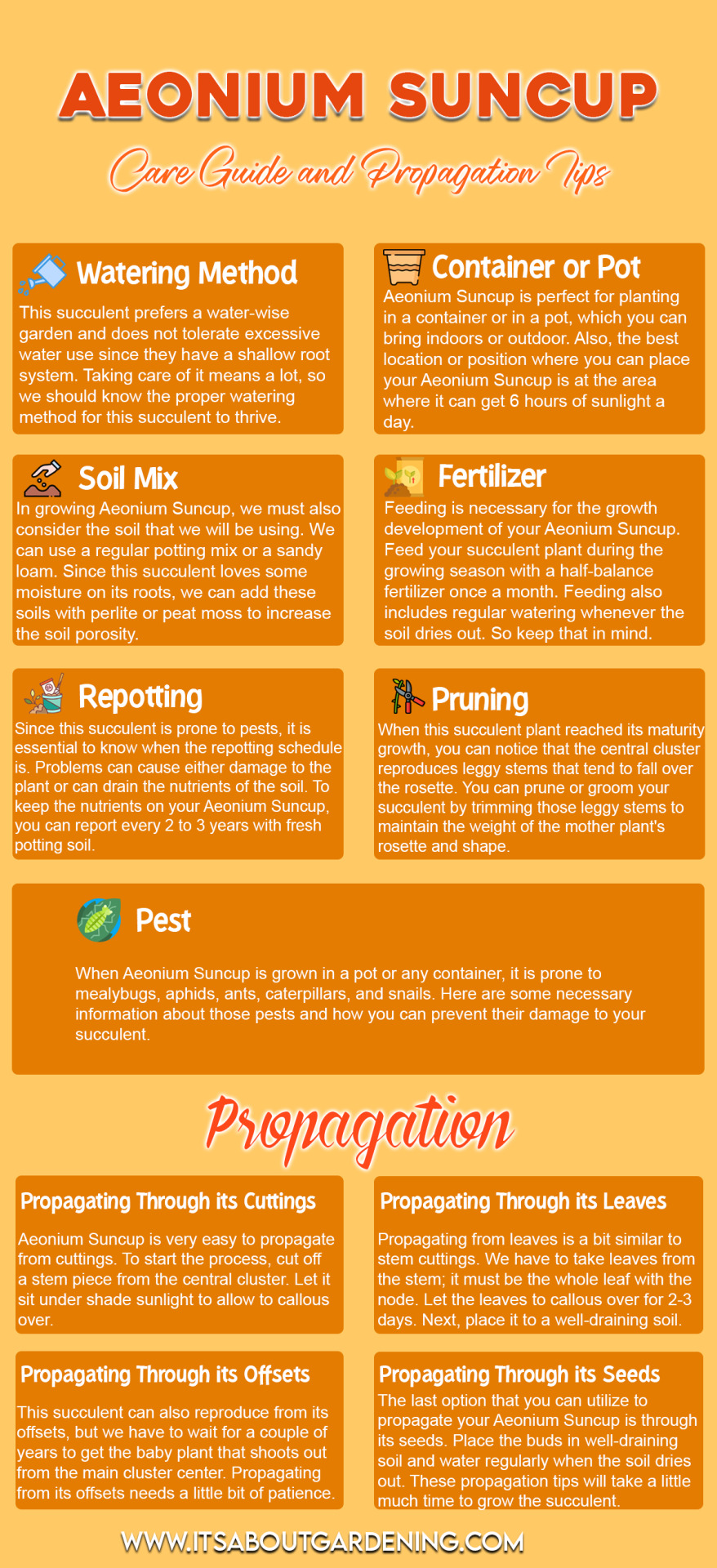

Aeonium Suncup Care Guide
Taking care with this aeonium succulent is a bit delicate than those various other succulents. If we have proper expanding problems, Aeonium Suncup needs really little pampering.
Below are some pointers on properly caring for your Aeonium Suncup and also pointers on propagating it.

What is the watering method that is best for Aeonium Suncup?
This succulent chooses a water-wise garden as well as does not endure too much water make use of because they have a shallow origin system. Caring for it indicates a whole lot, so we must understand the appropriate watering technique for this succulent to thrive.
Initially, make sure that the pot or container has great drain. Second of all, water your Aeonium Suncup throughout summertime as well as springtime whenever the soil dries. Decrease the water in the winter and also do not overwater.
During summer with extreme warm, you don't have to stress when its leaves begin to curl. The succulents act that way to stop the main collection from water loss, which's typical. The secret is for a healthy succulent plant; water it once the dirt has actually been completely dry for a while.

Where should Aeonium Suncup be planted?
Aeonium Suncup is best for planting in a container or in a pot, which you can bring inside or exterior. Also, the most effective location or position where you can put your Aeonium Suncup goes to the area where it can obtain 6 hrs of sunshine a day.
It enjoys brilliant sunlight, however excessive warmth, particularly during summer, might suffer your succulent plant. It's suggested to maintain your Aeonium Suncup in brilliant or shade sunlight, specifically during the early morning but not expose it to the sunlight throughout summer.
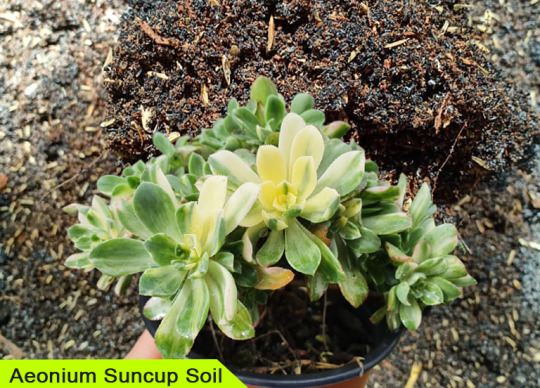
What soil is suitable for Aeonium Suncup?
In expanding Aeonium Suncup, we have to also think about the soil that we will be utilizing. We can use a regular potting mix or a sandy loam. Since this succulent likes some dampness on its origins, we can add these soils with perlite or peat moss to raise the soil porosity.
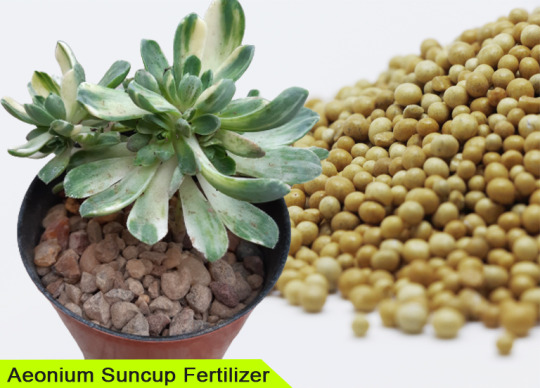
How to feed Aeonium Suncup?
Feeding is necessary for the growth advancement of your Aeonium Suncup. Feed your succulent plant during the growing season with a half-balance plant food as soon as a month. Feeding additionally consists of regular watering whenever the soil dries out. So keep that in mind.

Repotting Aeonium Suncup
Given that this succulent is prone to parasites, it is necessary to recognize when the repotting routine is. Troubles can create either damage to the plant or can drain pipes the nutrients of the soil. To maintain the nutrients on your Aeonium Suncup, you can report every 2 to 3 years with fresh potting soil. You can either use sandy loam or a routine potting mix.
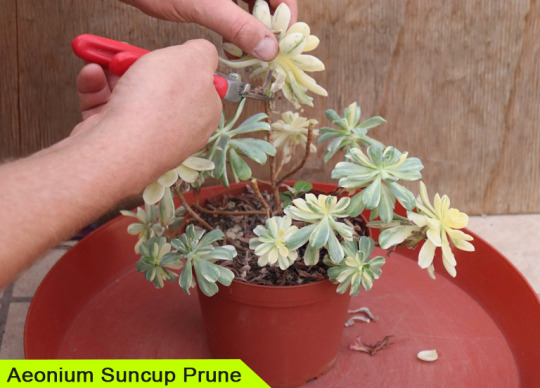
How to prune Aeonium Suncup?
When this succulent plant reached its maturation growth, you can observe that the central collection reproduces leggy stems that often tend to tip over the rosette.
You can prune or brush your succulent by trimming those leggy stems to preserve the weight of the mother plant's rosette and also form.
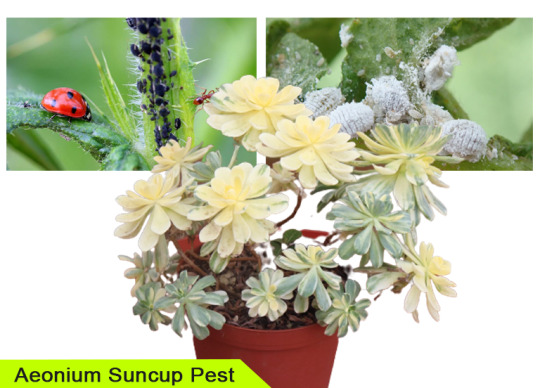
What are the Pest and Diseases of Aeonium Suncup?
When Aeonium Suncup is expanded in a pot or any container, it is prone to mealybugs, aphids, ants, caterpillars, and also snails. Right here are some necessary info concerning those insects as well as just how you can stop their damage to your succulent.
● Mealybugs: Aeonium Suncup may bring in mealybugs, as well as they conceal between the fallen leaves, or they can straight attack the roots of your succulent plant. Mealybugs are generally little and also extremely simple to miss out on. They can draw the sweet compound of Aeonium Suncup that advertises the development of mold and mildew. To avoid the damage they may cause, make use of a cotton bud to scrub alcohol and straight apply it to mealybugs. You can additionally spray massaging alcohol onto the mealybugs and also white fluff.
● Aphids: Aphids frequently stay in the facility of the rosette, and also they strike it eventually. In some cases, you can see these insects hiding bottoms of the fallen leaves of your succulent. They are typically small and environment-friendly or black. They sap the sweet white material of your succulent plant. To prevent aphids from striking your Aeonium Suncup, treat your succulent with soapy water and also spray extensively.
● Ants: Ants are the doubles of mealybugs and also aphids. Wherever aphids and mealybugs are, there will certainly be ants. To avoid ants' intrusion of your succulent plant, spray your succulent plant with soapy water or insecticidal soap.
● Caterpillars and Snails: Though these bugs are environmentally friendly, they might cause damage to your Aeonium Suncup. The leaves of your succulent plant are the preferred dish of caterpillars as well as snails, so beware. To avoid them eliminate the affected leaf of your succulent, pour smashed eggshells around the primary plant as well as pot. As we understand, caterpillars and also snails have delicate skin; they do not such as sharp items.
How to propagate Aeonium Suncup?
Through its Cuttings
Aeonium Suncup is extremely simple to propagate from cuttings. To begin the process, removed a stem item from the main cluster. Let it sit under color sunshine to allow to unsympathetic over. After 2-3 days, you can now replant it in a new pot with well-draining soil. Do not forget to water extensively once the soil is dry.
Through its Leaves
Propagating from leaves is a little bit similar to stem cuttings. We have to take fallen leaves from the stem; it must be the entire leaf with the node. Let the fallen leaves to callous over for 2-3 days. Next, place it to a well-draining soil. Water extensively whenever you see that the soil mix has dried out.
Through its Offsets
This succulent can additionally recreate from its offsets, however we need to wait for a number of years to get the baby plant that shoots out from the major collection facility. Circulating from its offsets needs a little of perseverance.
After we obtained the baby plant, remove it from the main collection and also sit for 2-3 days to dry. Replant in a pot as well as usage well-draining soil. You can change your soil with perlite or peat moss for soil porosity enhancement. Do not sink with a lot of water; saturate the soil mix and also repeat whenever it dries out.
Through its Seeds
The last choice that you can make use of to circulate your Aeonium Suncup is with its seeds. Area the buds in well-draining soil as well as water frequently when the soil dries out. These propagation pointers will take a little much time to expand the succulent.
Little yet horrible, that's the perfect line for Aeonium Suncup. Its main feature is being small, however it can offer immense happiness to your yard setting. Dealing with it might be difficult, however with this post's aid, every person will certainly do well in expanding this succulent. The advantage about Aeonium Suncup is that you can grow it in your garden any time of the day, and it is harmless to humans and also pets. So everybody will certainly delight in growing and growing Aeonium Suncup.
#Aeonium Suncup Care Guide#What is the watering method that is best for Aeonium Suncup#Where should Aeonium Suncup be planted#What soil is suitable for Aeonium Suncup#How to feed Aeonium Suncup#Repotting Aeonium Suncup#How to prune Aeonium Suncup#What are the Pest and Diseases of Aeonium Suncup#How to propagate Aeonium Suncup
0 notes
Text
AURORA BOREALIS KALANCHOE CARE GUIDE / Its About Gardening

Aurora Borealis Kalanchoe is a fascinating sight to see. Frequently called Bryophyllum Fedtschenkoi Variegata or Aurora Borealis, this plant can inform you how it really feels as it can exhibit certain changes in its hues when temperature level, soil dry skin, and the sunlight is being also less or too much.
This succulent hedge grows up and down. It has branches that spread out and root along the ground to develop substantial swarms. This plant normally takes over an entire area if entrusted to its own tools over an extended period. In ideal conditions, they can mature to 60 centimeters high and also distribute their children via the sides of their leaves.
Besides that, its leaves have lavender-gray-green with cream-colored variegation along the scalloped leaf margins that are thick as well as lush. While, in terms of color and also type, the leaves of the Kalanchoe Fedtschenkoi Variegata are both really consistent.
The facility of them stays reasonably environment-friendly, however the edges alter shades from lotion to pink to dazzling pink. Each fallen leave will certainly be different in shade, yet they will certainly all have the very same round, scalloped sides.
Its flowers are reddish-brown, bell-shaped, and also 2 centimeters long, and also they bloom in loose collections from late springtime to early summertime on upright stems.
The term Bryophyllum discovered in this plant's usual name Bryophyllum Fedtschenkoi Variegata was stemmed from the Greek words "Bryon/bryein" (grow) as well as "phyllon" (leaf). Bryophyllums belong to the Crassulaceae household plant category as well as swelling with Kalanchoe. The group includes about forty types that are native to Asia, South Africa, as well as Madagascar.

Taxonomic Hierarchy of Aurora BorealisKalanchoe
Kingdom: Plants
Subkingdom: Green Plants
Infrakingdom: Land Plant Kingdoms
Superdivision: Embryophyta
Division: Vascular Plants
Subdivision: Seed Plants
Class: Magnoliopsida
Superorder: Saxifraganae
Order: Saxifragales
Family: Stonecrops
Genus: Bryophyllum
Facts to Know About Aurora Borealis Kalanchoe
Scientific name: Kalanchoe Fedtschenkoi Variegata
Common Name: Aurora Borealis Kalanchoe
Type of Plant: Succulent
Height: 0.50 m.
Width: 0.50 m.
Blossom Color: orange
Growing Period: early springtime until late winter season
Light: complete to partial shade
Temperature : not frost forgiving
Water: minimal amount
Soil: free-draining, light soil
Fertilizer: fluid or pellet
Propagation: by leaf-cutting
Aurora Borealis Kalanchoe General Care
Kalanchoe Fedtschenkoi Variegata is a slow-growing succulent. Nonetheless, despite having that, it can still be expanded indoors or outdoors, for it is a low-maintenance plant.
Light
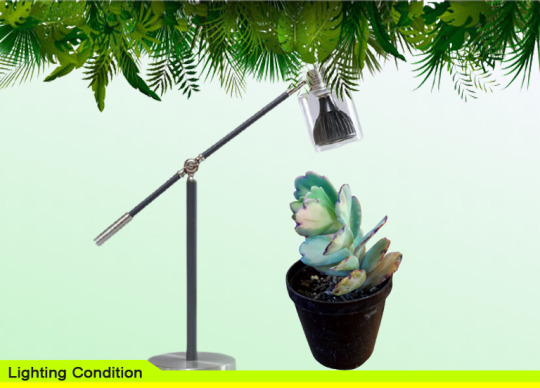
Kalanchoe Fedtschenkoi Variegata requires a full to a partial shade of sunshine to prosper, so they must be kept in a light-filled setting.
If you want to expand this succulent in a pot, bear in mind that you should place it alongside a window step where the early morning sun sparkles as well as keeps it far from intense heat. While if you are intending to place it in a garden, make certain it gets lots of sunlight.
Temperature

The Kalanchoe Fedtschenkoi Variegata is ecologically delicate, and also it can not endure frost. Though it is not as fussy as various other indoor houseplants that call for a temperature level of 55 to 80 levels Fahrenheit to prosper, this plant does not require you to do much to develop the perfect indoor setting, aside from not letting it freeze.
While for exterior setups, it requires a temperature level of around 45 degrees Fahrenheit or higher to make it through due to the fact that they are belonging to tropical as well as subtropical environments. Temperatures in between 65 and also 85 levels Fahrenheit on the other hand, are excellent for its growth and flowering.
Water

Overwatering is a huge NO for Aurora Borealis Kalanchoe as it only requires a minimal quantity of water. Much like any other succulent, soak and dry is the handiest means to irrigate this plant as it maintains wetness in its fallen leaves. It ought to likewise be maintained underhand.
Soil

Free draining pipes and also light dirt is a need to for the Aurora Borealis Kalanchoe to survive. To make certain that the soil you are utilizing is suitable, purchase a cactus or succulent soil that drains pipes well. If you can not find this, you may blend a quantity of 50% sand or perlite into a 50% potting soil/cactus mix. A 60/40 peat moss/perlite mix may likewise suffice to enhance water drain.
In most cases, you should likewise take into consideration the pots you are utilizing. Clay pots are suitable for growing your succulents as this will certainly aid in the wicking of excess water from the soil by helping in guaranteeing correct drain as well as staying clear of overwatering of the plant.
Fertilizer

Kalanchoes do not call for fertilizers. However to keep it healthy and balanced as long as feasible, normal feeding to enhance its nutrients is a good idea to do. Liquid or pellet fertilizers are a good idea to satisfy your plant's needs but make certain that you adhere to the specific amount and kind of nourishment they require as soon as possible when you feed your plant.
Remember, reviewing and complying with the instructions could be of terrific assistance to feed your Kalanchoe Fedtschenkoi Variegata correctly. Mainly Kalanchoes are fed during the springtime and also summer. While in winter, they prevent feeding it as it does not need several nutrients.
Maintenance and Grooming

Little to no maintenance is what a Kalanchoe Fedtschenkoi Variegata requires. All you require to do is to deadhead it or remove spent flowers to keep the pots and also your garden clean-looking.
And also when the watering time gets here, make sure to spray the plant to remove soil as well as maintain its fallen leaves and blossoms fresh-looking.
Pest and Disease of Aurora Borealis Kalanchoe
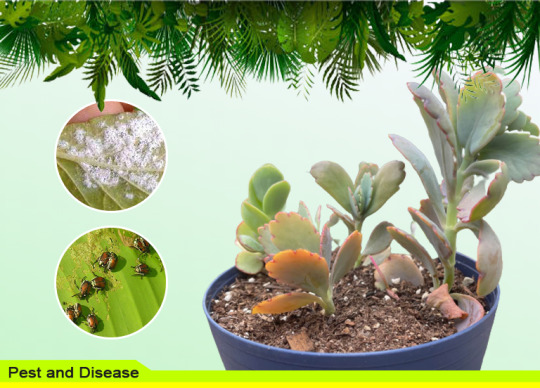
Succulents like Kalanchoe Fedtschenkoi are known to be parasite and disease-resistant as long as you look after them properly. So, they only need minimum to no maintenance whatsoever.
However, as soon as you overlook the plant, undetected bugs, mites, as well as others could be troublesome as these insects are leaf fans. So when watering your succulents, better examine it for they may be termites, beetles, or various other insects.
Once a trouble seems to develop, resolve it promptly. Light chemicals are of considerable help, or for critters, scrubing a 70% isopropyl alcohol on the plant parts, utilizing a non-toxic insecticidal spray, or neem oil spray is practical.
Propagation by Leaf
If you currently have an Aurora Borealis Kalanchoe succulent, you have seen that it generates offsets, which you can utilize to expand extra plants. The little plants emerge from the moms and dad plant's fallen leave suggestions as well as count on the parent plant for assistance as they grow origins.
To propagate by leaf:
1. Twist a leaf from the mom plant starts the process.
2. Keep in mind that if a leaf is affixed to the stem, you will have a lower probability of succeeding.
3. Enable the leaf to dry for a few days so completion calluses over.
When there are calluses, plant them in well-draining soil. And also when the planet is entirely completely dry, water it. Take care of it just how you would look after a grown kalanchoe.
#LIGHTING CONDITION#TEMPERATURE#WATERING#SOIL MIX#FERTILIZER#MAINTENANCE AND GROOMING#PEST AND DISEASE
0 notes
Text
CRASSULA BABY NECKLACE SUCCULENT CARE / Its About Gardening

Crassula Baby Necklace, fleshy, and also tightly piled leaves that expand along its thin stem. Its grayish-green leaves have attractive red in intense light on the margin, intensifying with even more sunlight direct exposure. It can mature to 8 inches high and 4 inches wide.
The type of this succulent appears like a string of grains or a beaded necklace of a baby, which is why it is called Baby Necklace.
Like other Crassula species, Crassula Infant Locket flowers white, little flowers from late springtime to early summer season.

Crassula Baby Necklace Care Guide
The Crassula Baby Necklace could be an unchallenging plant to expand due to the fact that it can thrive in a brief period of neglect. Nevertheless, even if you are a novice, there's absolutely nothing to fret about when expanding Baby Necklace.
If you plan to grow this succulent, right here are the complying with essential treatment guides you need to need to take into consideration.
Watering Procedure
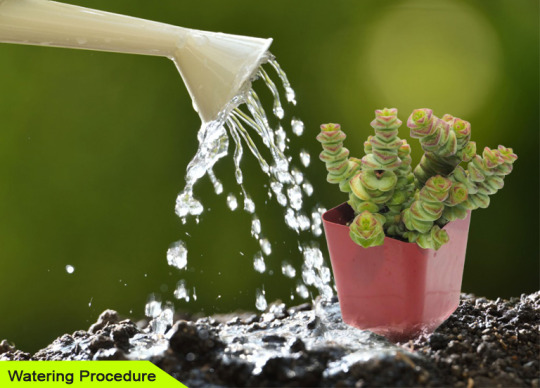
In growing succulents, appropriate watering is necessary. It can be a little bit tricky since it typically depends on the current climate where you live. There is no details schedule for when to sprinkle your succulents.
During summer season, Crassula Baby Necklace needs constant watering. The warmer the environment, the a lot more it needs watering as the soil gets quicker to completely dry.
Sprinkling your succulents likewise relies on where you grew your Baby Necklace. Succulents expanded inside your home require much less watering than outdoors because they have various environments, temperatures, and also lights problems.
Less watering doesn't indicate a percentage of water. Instead, it suggests decreasing the frequency of your watering.
The soil's wetness can be the sign of whether your Baby Necklace requires watering or not. You can check the soil's wetness by sticking your finger in the top inch of the ground. You can additionally utilize a wetness meter to gauge the soil's dampness. If the soil really feels wet, do not water it yet. Water only if the ground is dried out.
You can also inform if your succulent is lacking in water via its leaves. If the fallen leaves of your succulents obtain wrinkled, it is time to water your succulents thoroughly.
If grown in a container, water your delicious extensively till the excess water go through the drainage openings. After that, remember to pour off the excess water from the draining saucer.
Soil Requirement

An additional essential element in expanding Crassula Baby Necklace is the soil. Like other succulents, this plant needs well-draining soil. Utilizing fast-draining soil prevents your succulents from obtaining root rot. Otherwise, if the tool isn't fast-draining, sitting for a very long time in damp develops molds as well as microorganisms.
A well-draining soil makes up two materials, natural and not natural. Combine one part of natural product, routine potting soil, and two parts of not natural material: pumice, perlite, or crude sand.
This certain mix for succulents has remarkable water drainage and will dry out swiftly after sprinkling.
You can also create a tool for your succulents to make it easier to drain pipes if you stay in humid places.
Lighting Conditions

Like other succulents, Infant Pendant will prosper ideal if you provide adequate sunshine. They require at the very least four to six hrs of bright light to grow healthy and balanced and also stunning.
If you want to grow them outdoors, put them in position to obtain early morning sunshine rather than mid-day sunlight. Shield your Bbaby Necklace from the scorching sunlight in the mid-day to prevent the fallen leaves from burning.
Various other succulent growers wish to grow their Baby Necklace inside your home as decoration. However, it may not flourish if they lack intense light. Take into consideration putting them in locations where they can receive enough light, ideally near windows or window sill.
Baby Necklace has a tendency to extend or elongated if they lack light. If you notice this sort of habits, move your Bbaby Necklace to a brighter location. Utilizing expand light is an additional choice to supply adequate light if grown inside without sufficient light.
Pots and Repotting the Crassula Baby Necklace

Repotting your Crassula Baby Necklace after purchasing from Nurseries or Garden Centers is a must. Plants from Nurseries usually comes with a plastic container and also various sort of soil.
To repot your Child Baby succulent, knock off the old soil as well as transfer it right into a new container with appropriate soil for succulents.
In picking containers for your plants, it is important to have drain openings. Without drainage openings, your succulent will likely die as a result of root rot.
Crassula Baby Necklace will look good if grown in hanging baskets or lovable small pots as a screen to your house. It is also a perfect addition to any type of succulent plans.
Temperature

Crassula Baby Necklace is not cold-hardy succulent. They can endure mild frost as well as cold temperatures however not for a long term duration.
If you reside in USDA strength zones listed below 9, it is best to plant Baby Necklace in a container that you can bring inside your home. They will never survive in areas that have severe winter conditions otherwise expanded inside your home.
Crassula Baby Necklace can prosper at an ideal temperature of 65 ° F to 70ºF in summer.
Fertilizer

Feetilizing Crassula Baby Necklace is not required. However, to ensure their proper development as well as motivate flowers, they might require help.
For a plant to produce blossoms, they require great deals of power, and feeding them with nutrients will help them flower.
The excellent time to feed your plant is throughout the expanding season or spring and also summer season.
Apply a balanced mix of fertilizer diluted to half stamina every 2 weeks of the growing period.
Crassula Baby Necklace Propagation

Crassula Baby Necklace is an attractive succulent. It is one of one of the most appealing succulents that you will ever see. You will like to see even more of these little plants around your house as natural ornaments.
This suuculent is one of the easiest plants to propagate because it will only take couple of actions.
1. See to it that the plant you wish to multiply is fully grown currently.
2. Select a number of healthy-looking stems just in case several of them don't make it.
3. Cut stems with a clean set of scissors or pruning shears.
4. Remove excess fallen leaves from the stems' reduced end to reveal some nodes from which new roots will expand.
5. Allow the stems to dry for a number of hrs or a day to recover the cut part. Some succulents require even more prolonged durations to completely dry since they have thick stems. Crassula Baby Necklace has thin stalks enabling it to dry swiftly. You can additionally dip the cut-end in rooting hormone to accelerate the procedure as well as for a greater possibility of success.
6. Prepare a small container, preferably 2-3 inches pot, and loaded it with succulent soil mix.
7. Stick the cut end of the stem cuttings into the soil.
8. Please position it in a bright, shaded area as well as prevent exposing it to route sunlight.
9. Mist them from time to time but do not sprinkle them thoroughly until they developed new origins, concerning two weeks.
10. Anticipate them to be completely rooted after 4 to six weeks. You can likewise see brand-new development beside the stem reducing now.
Switch over to regular watering from misting as well as decrease the regularity of watering as the plant matures. You can likewise boost the quantity of light once the plant is completely rooted and developed.
Crassula Baby Necklace Pests and Problems

Before purchasing or bringing plants right into your home, always inspect it and also the container for indications of pests. It is best to move your plant to a brand-new pot to inspect the soil as well as inspect the roots thoroughly.
Constantly keep in mind not to put your newly gotten plants near your other plants. To be extra risk-free, you can quarantine your freshly bought plants for a month before joining them with others.
Unfortunately, Crassula Baby Necklace is susceptible to pests and also insects. If not dealt with early, it will pass away. Constantly check your Baby Necklace whenever you water them to prevent troubles from dispersing.
In growing succulents, there are couple of typical insects understood to be harmful to your beautiful plants.
Mealybugs are seriously fatal to succulents otherwise dealt with early. They sucked the dampness from the plants, resulting in rough leaves, and ultimately ran out your Baby Necklace.
Mealybugs
These are tiny white soft-bodied bugs and appear with small, white, cottony, weblike substance. Occasionally you might not observe those little bugs due to the fact that they conceal in the crevices of the leaves.
It is easier to get rid of the plant if the invasion is as well hefty. If light invasions, pick off mealybugs with cotton ideas dipped in alcohol.
One more choice is a natural spray, but make certain to scrape off any wax as well as insects, which additionally serves as added security.
Aphids
These are small sap-sucking insects in the superfamily Aphodoidea. You can typically see them feeding in clusters on new plant development.
Ants as well as aphids can develop mutually useful relationships that make problems also worse. For example, ants secure aphids from predators in return for honeydew secretions.
You can treat aphid problems with a strong jet of water to eliminate the bugs from the plants. You can likewise use a light soap mix splashed on the plant.
If this occurs, enable the plant to dry out completely and also reduce the watering. If the soil is not fast-drying enough, consider replacing the tool with more well-draining soil.
Sunburn
One more trouble that you may experience is the browning of the leaves, which signifies sunburn. Take into consideration moving your Baby Necklace into the shader part of your garden or indoors throughout the summertime. Severe warmth from the afternoon sunlight could likewise melt the fallen leaves of your succulents.
If you are a busy person and forgot to sprinkle your Baby Necklace, expect the plant's entrusts to be perished and also wrinkled. Withered fallen leaves could be an indicator that your plant is underwatered as well as requires a great drink. Instantly drench your plant completely to keep them hydrated. After couple of hours or so, the leaves will begin to liven up.
#WATERING PROCEDURE#SOIL REQUIREMENT#LIGHTING CONDITION#POTS AND REPOTTING#TEMPERATURE#FERTILIZER#PROPAGATION#PEST AND PROBLEMS
0 notes
Text
KALANCHOE MOTHER OF THOUSANDS CARE GUIDE / Its About Gardening

Kalanchoe Mother of Thousands, Mexican Hat Plant, or Alligator Plant, is a succulent plant belonging to Madagascar. It was formerly called Bryophyllum daigremontianum.
It can spread vegetatively from plantlets on its fallen leave margins, much like various other genera, Bryophyllum, currently included in the genus Kalanchoe.
You can locate a highly harmful steroid in all parts of this varieties, called daigremontianin. This plant reaches an elevation of 1 m as well as has opposing and whorled fleshy oblong-lanceolate fallen leaves that are 20 cm long and also 3.2 centimeters wide.
Kalanchoe Mother of Thousands has a complex cyme, an umbrella-like florescence, with little bell-shaped grayish pink or sometimes orange flowers.
Kalanchoe Mother of Thousands Scientific Information
Scientific name: Kalanchoe Daigremontiana Colony
Kingdom: Plantae
Subkingom: Viridiplantae
Infrakingdom: Streptophyta
Superdivision: Embryophyta
Division: Tracheophyta
Subdivision: Spermatophytin
Class: Magnoliopsida
Superorder: Saxifraganae
Order: Saxifragales
Family: Crassulaceae
Genus: Kalanchoe
Species: Daigremontiana
Plant Type: Succulent

Kalanchoe Mother of Thousands Basic Information and Facts to Know
Common name: Mother of Thousands, Mexican Hat Plant, Alligator Plant
Water Requirements: water frequently with a typical amount of water
Sun Exposure: Full to partial color
Height: 36 to 48 inches
Width: 36 to 48 inches
Danger: All components are poisonous if consumed
Flower Color: Pink Magenta, Pink-Purple, Orange
Soil pH: mildly acidic; neutral; mildly alkaline
Propagation: leaf cuttings
General Care Of Kalanchoe Mother of Thousands
The Kalanchoe Mother of Thousands is a lovely vegetation houseplant. The flowers of this plant are tiny when kept inside, and the most exciting attribute is the young plantlets that grow on the tops of the huge leaves frequently.
In USDA strength areas 9 via 11, Mom of Thousands may grow with small grayish lavender blossoms in late wintertime if expanded as an outdoor plant.
Light

Kalanchoe plants require a great deal of light to bloom, so they need to be kept in a light-filled environment. Potted plants should be maintained near a bright home window however far from windowsills and direct sunlight. 55 to 80 levels Fahrenheit is the ideal temperature for maintaining the plant warm.
Soil

Kalanchoe plants prosper in well-drained, well-aerated dirt. Choose or produce a blend that absorbs little water, such as a 50/50 potting soil/cactus mix or a 60/40 peat moss/perlite mix.
You can additionally expand your Kalanchoe in a clay container to ensure appropriate drainage as well as minimize overwatering. This soil mix will certainly help in the wicking of excess water from the soil as well as protect the plant's exposed roots.
Water

A Kalanchoe, a succulent with water-storing leaves, maybe the plant for you if you have a practice of neglecting to sprinkle your plants once in a while. The hardy plant only requires complete saturation once a week and even much less frequently in the winter.
In addition to that, make certain your Kalanchoe's soil is dry between waterings. Stick your finger into the first couple of inches of the soil mix to see if it is appropriately completely dry or ready to be sprinkled.
If you really feel any dampness, check once again in a few days. Keep in mind that sprinkling your Kalanchoe a couple of days late will certainly not hurt it. Simply see to it to moisten the dirt whenever it dries.
Temperature and Humidity

When it comes to its habitat, the Kalanchoe Mother of Thousands is not as fussy as various other indoor houseplants. Your plant can flourish in temperatures varying from 55 to 80 degrees Fahrenheit, except for not allowing it freeze since it can not withstand chilly temperatures.
To put it an additional way, you don't require to do much to develop the optimal indoor climate.
On the other hand, the Kalanchoe plant is not picky concerning humidity and does not require a particular moisture web content airborne. It is as straightforward as maintaining the plant away from drafts and cool windowsills.
Fertilizer
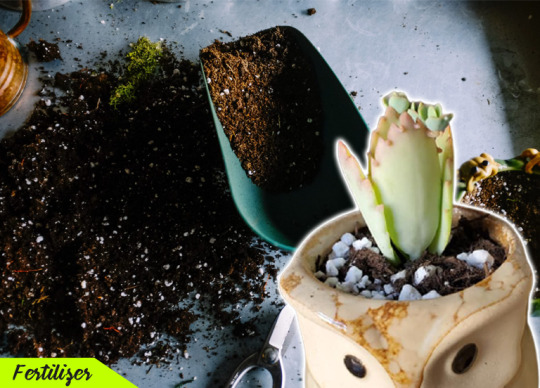
Plant food is beneficial to Kalanchoe Mother of Thousands, as it is to other blooming plants. Adding plant foods is necessary throughout the flowering period, so feed your plant once a month with a well-balanced plant food mix during the springtime and summer months.
If you're having problems getting your plant to flower, look for a potassium-based fertilizer. Potassium will certainly assist your plant in generating more buds.
Pinch back or deadhead light bulbs to encourage extra blooms. Allow the plant to remainder after deadheading and water as low as possible.
Kalanchoe Mother of Thousands Propagation
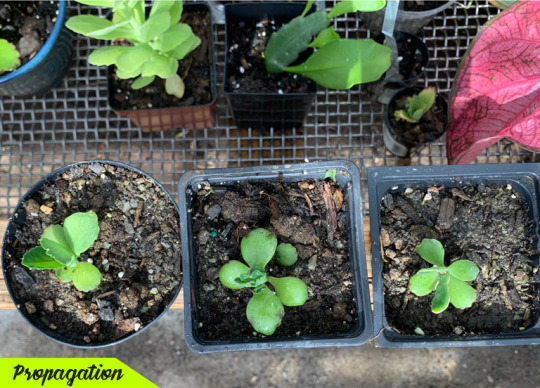
If you currently have a Kalanchoe succulent, you have seen that it produces offsets, which you can use to expand additional plants. The small plants arise from the parent plant's leaf suggestions and also count on the parent plant for support as they expand origins.
These pups take in a substantial amount of the parent's sources. As a result, taking over the proliferation yourself would certainly be much more effective and less demanding for the plant.
Steps in Propagating Kalanchoe Daigremontiana Colony by Leaves:
1. Remove leaves or beheading-- Get rid of a few fallen leaves from your succulent plant randomly, turning the fallen leaves very carefully to get rid of the whole fallen leave without damaging them. You can take them from the bottom half of the stem, thrown out if it becomes leggy. To eliminate a solitary fallen leave from some plants, you might need to utilize scissors. If you are "beheading," cut the stem easily concerning an inch listed below the lower one with your scissors or clippers.
2. Callus off-- Put the clippings in a container or tray of your choice. They are not choosy. There is no need for potting medium or water. In around 5 days, inspect to see if each has actually developed a callus on the cut end. Unsympathetic avoids microorganisms from permeating the unsafe soft cells.
3. Grow roots-- Over the following 3 weeks, watch out for origin growth. As they supply food for growing brand-new plants, leaf cuttings will start to wither.
4. Plant-- Fill up well-draining containers with potting tool or pick a garden spot matched for growing as soon as roots have actually formed. Conversely, you can mix a handful of sand or perlite with standard potting soil. Sunlight and also well-drained soil are suitable for succulents. They become light in the absence of the sunlight, and also they rot in the presence of way too much water.
5. Water and Fertilize-- Water lightly the next day as well as thoroughly tamp the dust down. Your brand-new plants' growth will accelerate as they adapt to their brand-new setting. It is now time to head out and acquire some delicious or cactus food.
Kalanchoe Mother of Thousands is a succulent plant that can withstand long periods of drought with little or no water. This plant needs adequate nourishment during growth phases with higher temperatures as well as higher water schedule, without which leaves show deficiency indicators such as stunted growth and also pustule-like illness. Because the plant is not frost-hardy, it normally dies when temperatures go down below freezing.
0 notes
Text
KALANCHOE DELAGOENSIS (MOTHER OF MILLIONS) CARE GUIDE / Its About Gardening

Kalanchoe Delagoensis, generally referred to as the Mother of millions is a popular houseplant and succulent plant native to Madagascar but naturalized in Tanzania and also Uganda.
It comes from a team of plants that reproduce asexually by forming plantlets along the fallen leave margins. These then be up to the ground, where they might conveniently root and also prosper in practically any atmosphere.
In some areas of the world, it has actually expanded invasive. It blooms with a collection of sagging tubular blossoms at the tips of stems throughout the winter months.
This plant is additionally fairly simple to grow in cactus as well as succulent potting mix in a pot with multiple drainage openings. Simply allow the soil to dry completely in between watering as well as plant in full sunlight to partial shade. If you move this plant outside in the summertime, it might sprout in various other pots or even on the ground.
Kalanchoe Delagoensis Scientific Information
Scientific name: Kalanchoe Delagoensis
Domain name: Eukaryotes
Kingdom: Plants
Subkingdom: Vascular plants
Superdivision: Seed plants
Divison: Blooming plants
Class: Dicotyledons
Subclass: Rosidae
Order: Rosales
Family: Stonecrop
Genus: Kalanchoe
Species: Delagoensis
Plant Type: Succulent
Kalanchoe Delagoensis Basic Information
Common name: Chandelier Plant, Devil's Backbone, Kalanchoe, Mother-In-Law-Plant, Mother of millions
Height: 20 to 28 inches
Weight: varies
Blooming season: Winter season
Life Cycle: Perennial
Habit or Form: Erect
Growth Rate: Medium
Maintenance: Medium
Flower Description: 1 to 1.5 inches long tubular reddish to orange blossoms with some yellow on the within, blossom in a dangling cluster on top of stems.
Stem Color: Green
Aromatic Stem: No
Stem Description: Put up environment-friendly with short sterile branches at the base, 3 feet high.
Leaf Description: Fallen leaves are primarily opposing or whorled in threes and spaced similarly. The petiole and blade are identical from reddish-green to gray-green with reddish-brown patches, directly elongate, sub-cylindrical, as well as grooved. The sides whole save for 3 to 9 conic teeth at the pinnacle, which are 1 to 6 inches long by 1 to 2 inches vast.
Fruit Description: Fruits are indehiscent, papery roots with many seeds that are dry and indehiscent.

Facts to Know about Kalanchoe Delagoensis
Light: direct sunlight 6 or more hours a day, a partial shade of 2 to 6 hours a day
Temperature level: 60 to 71 levels Fahrenheit
Water: very little watering
Soil Texture: Loam (Silt), Sand
Soil drainage: Good Drain, Sometimes Dry
Fertilizer: fluid plant food or slow-release pellets
Potting: clay pots
Propagation: fallen leave cutting
USDA Plant Hardiness Area: 10b, 10a, 11b, 11a
Landscape Location: Container
Landscape Style: Dry Spell Tolerant Garden
Resistance to Challenges: Dry Soil
Problems: Problem for Cats, Trouble for Dogs, Trouble for Steeds, Weedy
Poison Severity: Low
Causes Contact Dermatitis: No
Kalanchoe Delagoensis "Mother of Millions" Care Guide
Kalanchoe Delagoensis is simple to grow. If you do not have enough fresh starts, you can rapidly start new plants from virtually any kind of portion of the mother plant.
Light
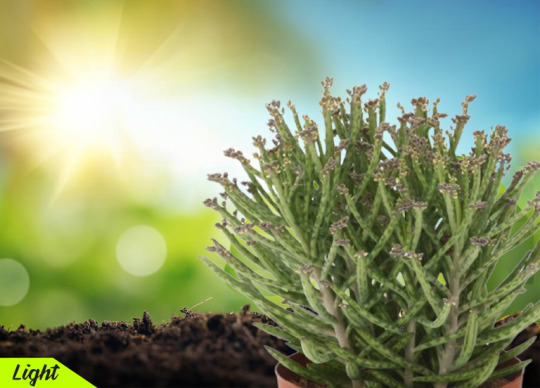
This plant favors intense light as well as flourishes in a warm place. However, it is sensitive to the full intensity of lunchtime sunlight with the glass.
Offer the plant extra sunshine if it is expanding leggy, with light leaves and also less marbling. However, keep the plant out of straight sunshine.
Temperature

The Kalanchoe Delagoensis can endure light frost and subzero conditions, but just for a quick time. Temperature levels between 60 ° F as well as 71 ° F( 16 ° C and 22 ° C) are best for this succulent.
Therefore, if you live in a chillier climate with freezing temperature levels during the wintertime, you must expand your Chandelier Plant in a container that you can bring within during the winter months.
Water

Kalanchoe Delagoensis is very drought forgiving. It does, however, benefit from normal watering one or two times weekly from spring with loss as well as much less in the wintertime.
Prevent overwatering, as well as do not allow the pot sit in a swimming pool of water. Overwatering can cause drooping fallen leaves and also early shedding of young plants.
Enable the plant to remainder as well as completely dry thoroughly prior to watering it again.
Fertilizer

Kalanchoe Delagoensis does not call for fertilization. With ideal nutrients from the soil medium, the succulent expands well. If you desire your succulents to expand also much healthier and also lusher, feed them to provide an additional increase of nourishment. Feed your succulents every 2 to 4 weeks or as soon as a month with fluid plant food or slow-release pellets.
Maintenance and Grooming

Trimming is a simple method to keep your plant healthy and balanced as well as clean. This activity of removal of dead or rotten fallen leaves, in addition to invested blooms, must only be done if crucial.
You can rarely clip the Kalanchoe Delagoensis because it is a medium-growing succulent. And all you need for trimming it is a pair of scissors to trim the plant's components that you do not like as well as eliminate used flowers to make sure that your plant will look better in the following active season.
Pest and Disease

This plant is immune to a variety of ailments. A mildew infection can occur as a result of dry air. Use a fungicide to treat the problem. Mist the plant a lot more often. In places like Australia and the Pacific Islands, this plant is thought about an intrusive weed.
Kalanchoe Delagoensis Propagation
Growing Kalanchoe in a large container or perhaps as a houseplant can aid individuals with even more good conditions find out exactly how to expand Kalanchoe as well as keep it within bounds.
While dry spell and also warmth resistance are substantial, the plant also thrives in wet settings and also can usually recuperate from a light winter freeze.
Remove frequently the tiny plants that have actually leaped from the container into the ground or another pot for Kalanchoe Delagoensis upkeep. The Kalanchoe Delagoensis plant generates tiny plantlets at the end of the fallen leaves, which causes this. The elimination of these plants from undesirable locations is an essential element of their treatment.
Steps in Propagating Kalanchoe Delagoensis: (by leaves)
1. Remove leaves or beheading-- Remove a few leaves from your succulent plant randomly, turning the fallen leaves carefully to get rid of the whole fallen leave without harming them. Do these from the bottom fifty percent of the stem, which you can ignore if it ends up being leggy. To remove a single leaf from some plants, you might require to use scissors. If you're "beheading," reduced the stem cleanly regarding an inch listed below the lower one with your scissors or clippers.
2. Callus off- Place the cuttings in a container or tray of your selection. They aren't particular. There is no demand for potting medium or water. In about 5 days, examine to see if each has created a callus on the cut end.
3. Grow roots-- Over the following three weeks, watch out for root development. As they give food for expanding brand-new plants, fallen leave cuttings will certainly begin to perish.
4. Plant-- Fill well-draining containers with potting tool or choose a yard area suited for planting when origins have created.
5. Water and Fertilize-- Water gently the following day and also meticulously tamp the dust down. Your brand-new plants' development will accelerate as they get used to their new environment. It is now time to head out and acquire some succulent or cactus food.
Note: Various other approaches for propagating succulents consist of callusing cuttings in addition to potting mix, permitting them to root directly in the soil. If you desire to construct your potting nursery for a multitude of cuttings at the same time, this technique is perfect; nevertheless, you should keep the soil dry while the cuttings callus as well as grow origins.
Danger.
The chemicals termed bufadienolides, which can create heart failure if ingested, threaten family pets and also wild animals when growing Kalanchoe Delagoensis.
Animals unfamiliar with the sampling may be uninformed of the possible risk and blunder it for a tasty reward. Orange blossoms are alluring to some garden enthusiasts; as a result, they agree to take the danger.
Keep this odd plant out of reach of your animals or behind a little fence if you choose to grow it in a container or as part of an outdoor screen to avoid injury to your family pets and also going to wildlife.
#Kalanchoe Delagoensis Scientific Information#Facts to Know about Kalanchoe Delagoensis#Light#Temperature#Water#Fertilizer#Maintenance and Grooming#Pest and Disease#Kalanchoe Delagoensis Propagation
0 notes
Text
LEAF PROPAGATION OF BLUE ROSE ECHEVERIA / Its About Gardening

Leaf Propagation of Blue Rose Echeveria-- Circulating succulents like the Blue Rose Echeveria is very easy and also fairly exciting. There are additionally different methods to do so, either using its fallen leave, stem cutting, seed, or countered.
This post will focus on Propagating Blue Rose Echeveria via its leaf. It is verified effective as well as genuinely an easy task.
If you question what the best season to reproduce this succulent is, it is throughout springtime or summer season. Stay clear of propagating the Blue Rose Echeveria while it is in its dormancy duration, which is during winter season.
The cuttings might have a difficult time expanding during that time as well as might even cause not successful breeding.

How to propagate Blue Rose Echeveria by leaf?
Fallen leave propagation is the most typically made use of strategy of reproducing succulents. It is likewise affordable and also requires much less job. But certainly, doing fallen leave propagation likewise calls for persistence and also effort to be done successfully as well as results in great results. You can refer to the guidelines listed below to replicate the Blue Rose Echeveria as well as the devices required
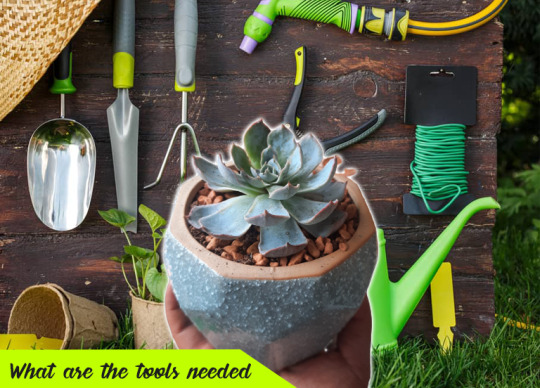
What are the tools needed?
1. A knife or scissor-- In cutting the leaf, you can make use of either a blade or a scissor. Simply ensure that you clean up the blade or scissors to prevent dangerous infections.
2. A well-draining pot-- Securing a well-draining container is a must. There must be holes permanently water drainage as well as sufficient room between cuttings.
3. A succulent soil mix-- The succulent soil mix to be made use of have to be well-draining also to avoid water retention, which most succulents hate.
4. A plant cover-- Making use of a plant cover will certainly make sure the security of the cuttings from damaging bugs as well as bugs.
Leaf Propagation of Blue Rose Echeveria

This guideline will provide you the step-by-step process on exactly how to circulate heaven Rose Echeveria correctly.
1. The initial step is to pick healthy fallen leaves from a healthy succulent. Next, see to it that the main plant has matured leaves right into where you can choose to multiply. The proliferation calls for expanded and healthy leaves for it to be a success.
2. The 2nd step is reducing the selected matured fallen leave making use of a scissor or a blade (take note that the tools you are going to use must be clean). Very carefully cut the fallen leaves as well as make certain that you eliminate the whole part of the fallen leave from the stem of the major plant. Be mild in detaching the leaves since you will require another one if that occurs.
3. After reducing the leaf, established it aside and put it right into a cozy location with low humidity. Airdry the leaves as well as allow it callous for few days.
4. Prepare a pot with a well-draining soil mix. Plant the leaf in an upright placement as well as maintain it far from direct sunshine. Much less sunlight exposure is what a newly grown fallen leave demand.
5. Water the cuttings after a week. The fallen leave still needs time to adapt to its brand-new setting.
6. You can place a plant cover to prevent harmful bugs from harming the cuttings.
7. Bear in mind to put the cuttings in a cozy location for much better outcomes. After weeks of correct caring, you will notice that the leaf begins creating origins.

Succulent Leaf Propagation Success Rate
A 100% success price is undoubtedly hard to achieve. Some cuttings might not make it through throughout the procedure, but most of them will certainly as long as you give appropriate care and adhere to the ideal method.
What to avoid when propagating Blue Rose Echeveria by leaf
● Avoid using broken or fallen leaf when propagating-- Dropped leaves are unhealthy leaves could contain germs. That is why you can not make use of these type of leaves in proliferation.
● Do not plant the cuttings right away-- The fallen leaves require to callous prior to planting. You ought to do this procedure to avoid infection.
● Do not water the cuttings immediately-- After growing the cuttings, prevent watering them. The leaves have to recuperate first and adjust to a new environment.
How long would it take for the cuttings to grow?
Few weeks after the cuttings were planted, you will see some small fresh fallen leaves establishing onto the suggestion of the main fallen leave. This development shows that fresh Blue Rose Echeveria is about to grow. Nevertheless, you will additionally see that as the new fresh succulent is growing, the major cuttings slowly dry out and will certainly quickly fall.

Growing Problems
1. Sunburn-- An expanding succulent is sensitive to excessive sunlight. Although sun direct exposure is required for the succulent to expand, excessive is wrong due to the fact that it can create sunburn.
A growing succulent that knowledgeable sunburn has a lower opportunity of survival. Better to leave an increasing succulent in an unethical place with just sufficient sunshine for 2-3 hours a day. If the temperature is too hot and you recognize that the expanding succulent can no more endure such weather, transfer the growing succulent indoors as well as place it near a window.
2. Stretched-out stems-- The leading root cause of this issue is absence of sunlight direct exposure. The amount of sunlight that an expanding succulent requirements to 2-3 hrs a day. If the succulent did not accomplish enough sunlight exposure, it might lead to a stretched-out stem.
3. Bruises-- Blue Rose Echeveria is just one of those succulents which are sensitive to abrupt bump. The damaged area will quickly have a black or brownish shade, which shows bruises. To prevent this sort of issue, take care when transferring the succulents as well as stay clear of touching the fallen leaves as long as feasible.
4. Root rot-- Excessive watering or water retention for also long is the leading root cause of this issue. To avoid this issue, you must understand the proper watering schedule of your succulents. Since they are still growing succulents, they do not require watering as soon as every 2 or 3 weeks. Ensure that the pot used is a well-draining one to drain water as well as prevent water retention quickly.
The propagated leaf can grow swiftly and a healthy diet as long as you give proper care. Don't lose hope if you ever before encounter unsuccessful breeding, as it will certainly act as an experience for you. Continue trying, and soon. You will definitely grow some beautiful Blue Rose Echeveria.
#How to propagate Blue Rose Echeveria by leaf?#Leaf Propagation of Blue Rose Echeveria#Succulent Leaf Propagation Success Rate#Growing Problem
0 notes
Text
HOW TO MAKE A DIY SOIL MIX FOR SUCCULENT BLACK PRINCE / Its About Gardening

Succulents like the Black Prince Echeveria are sensitive when it involves the soil they require to grow. Not all type of soil are suitable for growing the Black prince Echeveria
When you mistakenly picked the soil you utilized for your succulents, it may kill the plant. That is why you require to meticulously select or make the ideal soil for your Black Prince Echeveria. This short article will help and also show you exactly how to make a DIY soil mix for succulent Black prince.
The Best Soil for Black Prince Echeveria
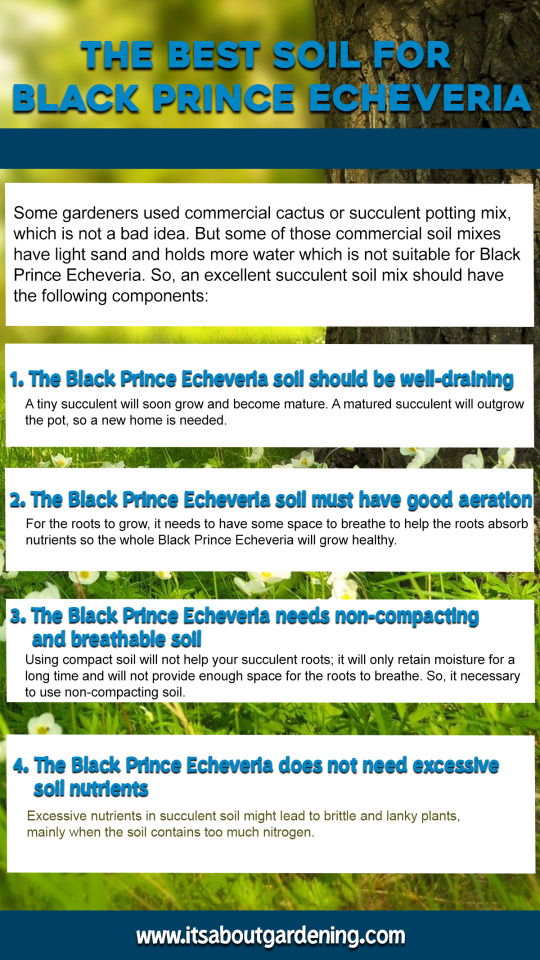
Some gardeners used commercial cactus or succulent potting mix, which is not a poor idea. Yet several of those commercial soil mixes have light sand as well as holds a lot more water which is not suitable for Black Prince Echeveria. So, an exceptional succulent soil mix should have the adhering to components:
1. The Black Prince Echeveria soil should be well-draining. Black Prince Echeveria must not be combined with wet soil because it might cause death to your plant. Most succulents choose soil that drains water well as well as swiftly. That is why it is best to utilize grainy and loosened soil.
2. The Black Prince Echeveria soil must have good aeration. For the origins to grow, it requires to have some area to breathe to aid the origins take in nutrients so the entire Black prince Echeveria will grow healthy.
3. The Black Prince Echeveria needs non-compacting and breathable soil. Utilizing small soil will not assist your succulent origins; it will only keep wetness for a long time and also will not give adequate room for the roots to take a breath. So, it necessary to use non-compacting soil.
4. The Black Prince Echeveria does not need excessive soil nutrients. Too much nutrients in succulent soil could cause fragile and slender plants, primarily when the soil contains too much nitrogen.
Take note also that excellent soil accomplishes three necessary tasks for the Black Prince Echeveria.
1. It provides nutrients to the plant, such as nitrogen as well as phosphorous.
2. It helps the origins to dig in and offers stability.
3. It absorbs water as well as makes wetness to assist the Black Prince Echeveria expand.
Benefits of Making Your Own Black Prince Echeveria Soil Mix
There are 2 main advantages to making your succulent potting mix. Initially, it is cheaper than acquiring commercial items, as well as 2nd, you manage the components you are executing your potting mix. Making a potting mix for succulents is also not expensive as well as will certainly conserve you cash.
Ingredients for DIY Black Prince Echeveria Soil Mix
In making your own Black Prince Echeveria succulent potting mix, you require the adhering to 3 components, which you can quickly discover at a garden center or plant store.

All-Purpose Potting Soil- This component is a natural potting mix that boosted myco-tone. It additionally improves dampness retention and advertises origin development. In picking what brand of all-purpose potting soil to use, you can use any kind yet stay clear of those which contain vermiculite or any moisture control potting mix that maintains water. Keep In Mind That Black Prince Echeveria requires well-draining potting soil and not the ones that hold moisture. Do not also use heavy yard soil; use light, permeable soil as your base rather.
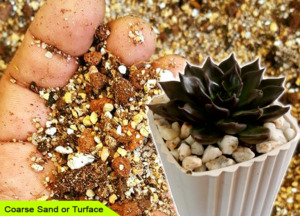
Coarse Sand or Turface- Coarse sand is natural earth sand that is rough in appearance. This ingredient offers heat to the plant as well as aids avoid root decomposing. Turface is a calcined clay and also the best additive for soil blends. Black prince Echeveria prefers porous sandy potting soil, so it is required to add sand to your succulent potting mix. Bear in mind too that not all kinds of sand appropriate to use for your potting mix. Like the ones that originate from the garden, sandbox, or coastline, some sand consists of bacteria that may be moved to your plant if used. It is way better to use crude sand to guarantee fast water drainage for the Black Prince Echeveria. If crude sand is not available, you can use turface as a substitute, either of the two will do.

Perlite or Pumice- These active ingredients are natural rocks that help loosen heavy soil as well as give small air pockets to the plant to advertise water drain and origin growth. Including perlite or pumice to your succulent potting mix will certainly stop soil compaction and gives better drain for your plant, which most succulents choose.
Other Supplies You Need
Apart from the potting mix active ingredients, you will likewise require the adhering to devices.
● Gauging container
● Container for blending
● Trowel
● Hand gloves
How to Mix Potting Soil for Black Prince Echeveria

Blending you're your own Black prince Echeveria soil mix is simple. You require to follow the dish and the actions below.
1. Three parts potting soil
2. Two components rugged sand or surface area
3. One part perlite or pumice
( you can include 1/2-- 1 part much more sand and also perlite for extra drainage).
What is "part"? It is a generic device of measure to make use of for your potting mix ratio. If you are not accustomed to this dimension, you can utilize any amount you want as long as it is equivalent for each "component.".
When every aspect prepares, you can now blend the ingredients. Prepare a blending container, then put every part on it. Using a trowel or your hands, mix everything and make certain that the active ingredients are equally mixed. Then your own Black prince Echeveria dirt mix is ready to make use of.
Storing Your Leftover DIY Soil Mix

The good idea regarding making your own Black Prince Echeveria soil mix is that you can compose a huge batch as well as store the extra later. Shop your soil mix in an air-tight container or bucket-sealing covers to prevent insects from getting involved in your soil mix. You can place your soil mix in your garage, cellar, or anywhere you want as long as it is safe from splashing. An additional thing is that you can use your soil mix just for produced Black Prince Echeveria but likewise for breeding. It will certainly conserve you a great deal of money.
* If in case you do not intend to get filthy as well as make your own Black Prince Echeveria potting soil mix, you can describe the adhering to business cacti blends.
● Black Gold Cactus Mix by Sunlight Gro Gardening-- It is a normal succulent mix that contains natural as well as inorganic active ingredients that give sufficient drainage for your plant.
● Bonsai Jack Succulent and Cactus Gritty Mix is a cacti soil mix with no organic matter and maintains no water.
The information over is all you require to recognize in making your succulent mix. Black Prince Echeveria is somewhat a fussy plant, like the majority of succulents, so you need to choose or make your soil mix. It is required to bear in mind that not every dirt will be useful for your Black Prince Echeveria. So, select carefully.
#ALL PURPOSE POTTING SOIL#COARSE SAND or TURFACE#PERLITE or PUMICE#HOW TO MIX POTTING SOIL FOR BLACK PRINCE ECHEVERIA#STORING YOUR LEFTOVER DIY SOIL MIX
0 notes
Text
KALANCHOE CARNEA SUCCULENT CARE GUIDE / Its About Gardening

Kalanchoe Carnea, typically called Modoc or Big Leaf Kalanchoe, is a 3 to 4 feet tall delicious with environment-friendly, glabrous leaves 2 to 3 inches wide by 4 to 5 inches lengthy and also blunt scalloped margins that are reflexed beneath.
In the summertime, this plant has flashy pink blossoms in terminal racemes peak above the vegetation. This plant thrives in dismal, disregarded parts of older gardens, where it may endure without water. In entire light, with some watering, the plants show up better and also will flower a lot more often.
It can endure temperature levels as reduced as the mid-twenties Fahrenheit without injury. For several years, this plant has been grown in Southern The golden state.
According to Mr. Stephen Jankalski, in 2002, Modoc is more than likely Kalanchoe Carnea which is associated with K.rosea, an Indian types from Assam initially explained in 1886.
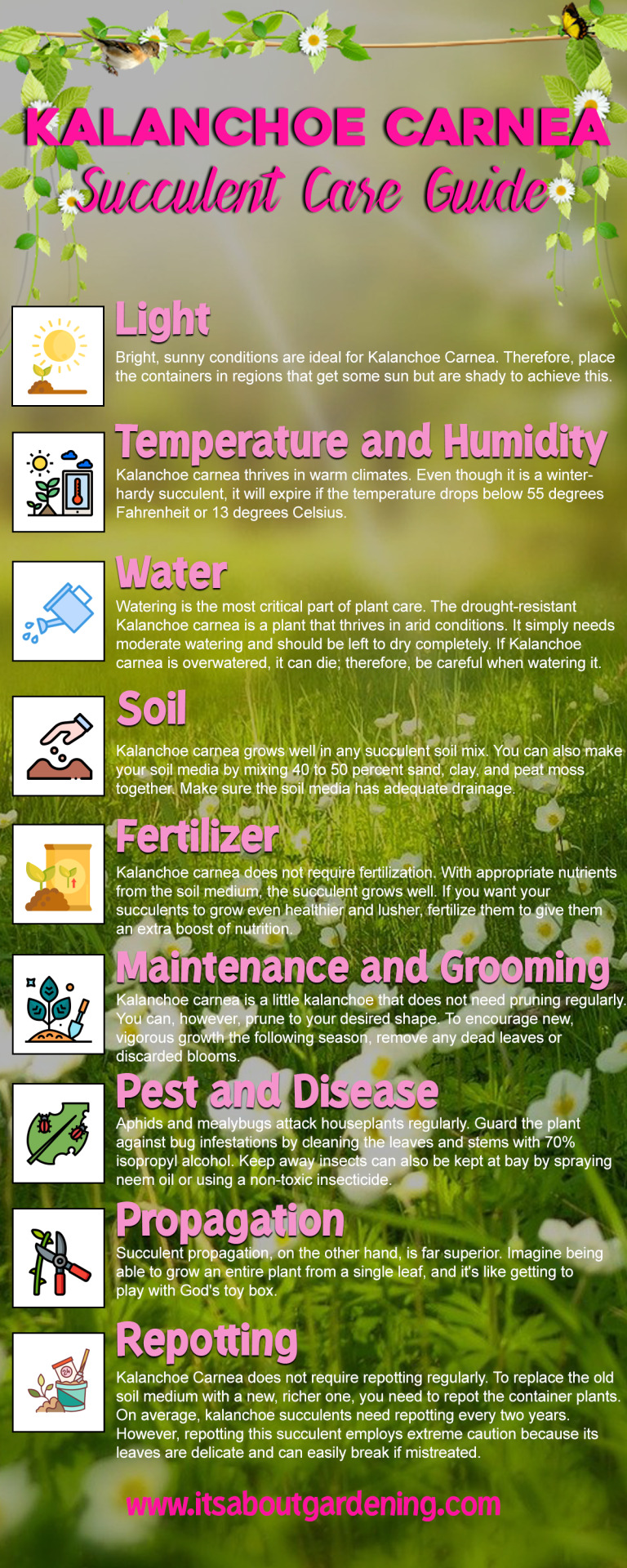
Kalanchoe Carnea Scientific Information
Scientific name: Kalanchoe Carnea
Domain: Eukaryotes
Kingdom: Plants
Subkingdom: Vascular plants
Superdivision: Seed plants
Division: Blooming plants
Class: Dicotyledons
Subdivision: Rosidae
Order: Rosales
Family: Stonecrop
Genus: Kalanchoe
Species: Carnea
Plant Type: Succulent
Kalanchoe Carnea Basic Information
Common name: Modoc or Big Leaf Kalanchoe
Height: 1.50 meters
Width: 0.25 meters
Flower color: pink
Blooming season: summer
Leaves: 2 to 3 inches wide and also 4 to 5 inches long
Facts to Know about Kalanchoe Carnea
Light: Sunlight dappled (Shield via upper cover throughout the day); The sun is shining (6 or more hrs of straight sunlight a day); Shade in Parts (Direct sunlight only part of the day, 2-6 hrs).
Temperature : 25 to 30 degrees Fahrenheit.
Water: minimal irrigation.
Soil: light and well-drained
Fertilizer: fluid plant food or slow-release pellets.
Potting: clay pots.
Propagation: leaf cutting.
Kalanchoe Carnea General Care
Although not every person is born with a green thumb, there are numerous pointers, hacks, and also methods that can help you maintain your plants to life and well.
Right here are the important things you need to understand about plant care if you wish to be a plant moms and dad.
Light
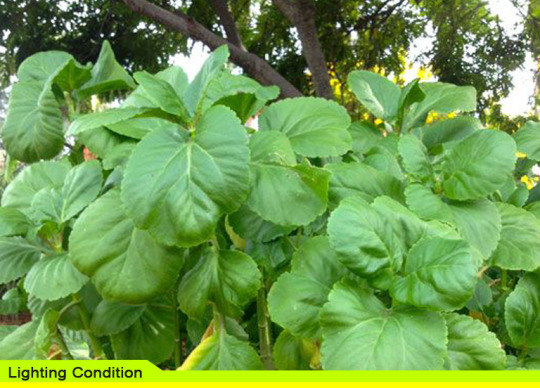
Bright, warm conditions are ideal for Kalanchoe Carnea. For that reason, place the containers in areas that get some sunlight however are questionable to accomplish this.
Place your interior plants near a home window that obtains a lot of light. It is best to prevent straight and bright sunshine. It could create the leaves or the pointers of the leaves to shed.
Temperature and Humidity

Kalanchoe carnea flourishes in cozy climates. Although it is a winter-hardy delicious, it will certainly end if the temperature goes down below 55 degrees Fahrenheit or 13 degrees Celsius.
In areas where the temperature level is freezing, you need to protect succulents from freezing damages. Location the plants in pots inside, and use frost towels to secure outside plants. Kalanchoe carnea prospers in low-humidity settings. It can survive in a variety of humidity levels.
Water
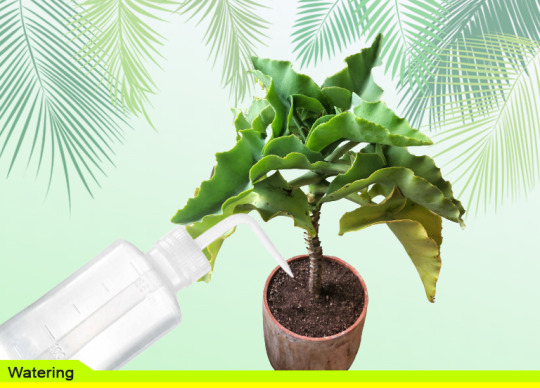
Watering is the most critical part of plant care. The drought-resistant Kalanchoe carnea is a plant that thrives in dry conditions.
It merely requires moderate sprinkling and also must be entrusted to completely dry totally. If Kalanchoe carnea is overwatered, it can die; therefore, beware when watering it.
Soil

Kalanchoe carnea grows well in any delicious soil mix. You can likewise make your dirt media by blending 40 to half sand, clay, and also peat moss together. Make certain the soil media has appropriate drainage.
Fertilizer

Kalanchoe carnea does not need fertilization. With suitable nutrients from the soil medium, the succulent expands well.
If you desire your succulents to grow even healthier and lusher, fertilize them to provide an added increase of nourishment.
Feed your succulents every two to four weeks or when a month with fluid plant food or slow-release pellets.
Maintenance and Grooming

Kalanchoe carnea is a little kalanchoe that does not need trimming frequently. You can, nonetheless, trim to your preferred form. To urge new, vigorous growth the adhering to period, eliminate any type of dead fallen leaves or thrown out blossoms.
Pest and Disease
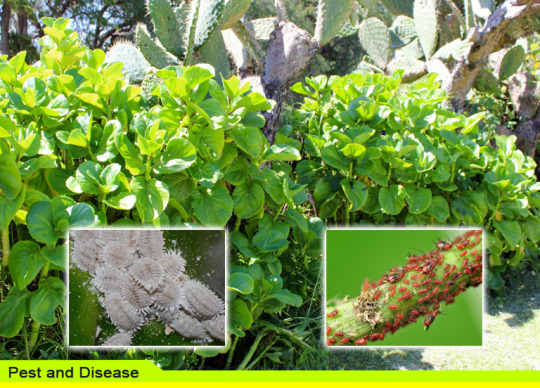
Aphids and also mealybugs assault houseplants consistently. Guard the plant against pest infestations by cleaning the leaves and stems with 70% isopropyl alcohol.
Maintain away bugs can also be kept at bay by spraying neem oil or using a safe pesticide.
Overwatering is another vital concern with Kalanchoe carnea. The roots of the succulents will certainly die if they are overwatered. Always allow the excess water drainpipe before including the next water.
Kalanchoe Carnea Propagation

Succulent propagation, on the other hand, is much exceptional. Picture having the ability to expand an entire plant from a single fallen leave, as well as it resembles reaching have fun with God's toy box.
Below are steps on how to propagate Kalanchoe carnea.
Steps in Propagating Kalanchoe Carnea
1. Get rid of a couple of leaves from your succulent plant at random, twisting the leaves delicately to remove the whole leaf without injuring them. Some plants may need making use of scissors to remove a single leaf. If you're "beheading," cut the stem regarding an inch listed below the top of the head.
2. Area the clippings in your favored container or tray. This plant is not choosy. There is no need for potting medium or water in this job. Inspect to identify if each has expanded a callus on the cut end after regarding five days. Bacteria are not able to penetrate the unsafe soft cells as a result of this.
3. Keep a keep an eye out for origin development during the next 3 weeks. Leaf cuttings will begin to wither as they give nutrition for the growth of brand-new plants.
4. Fill well-draining pots with potting tool, or locate a garden website where you can grow the established origins.
5. Alternatively, you can combine normal potting dirt with a handful of sand or perlite. Succulents prosper in intense light as well as well-drained soil. In the lack of sunlight, they get pale, and also in the existence of excessive water, they degeneration.
6. Plant in a warm location in the early morning or late afternoon, when the sun is much less extreme. Pile earth in addition to the cuttings to raise them above the edge of your container or garden surface. Gently tamp the ground down and do not water to secure the origins. Decorate with decorative rocks or pebbles as preferred.
7. The next day, water gently as well as gently lower the planet. As your brand-new plants season to their new environments, their growth will certainly increase. It's time to head out and also buy some delicious or cactus food.
Remember:
Callusing cuttings in addition to potting mix, enabling them to root directly in the dirt, are another approach for duplicating succulents.
In addition, this approach is ideal if you want to establish a potting nursery for a multitude of cuttings at the same time; nevertheless, you should maintain the soil dry while the cuttings callus and type roots.
Repotting
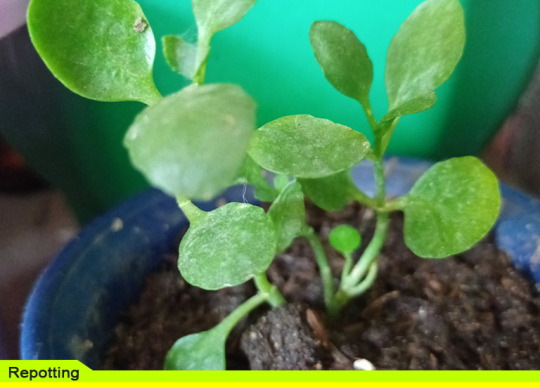
Kalanchoe Carnea does not require repotting routinely. To replace the old soil tool with a new, richer one, you require to repot the container plants.
Typically, kalanchoe succulents require repotting every 2 years. Nonetheless, repotting this succulent utilizes extreme care due to the fact that its fallen leaves are fragile as well as can conveniently break if maltreated.
Note: Clay pots, polished porcelains containers, and any other container with adequate drainage are ideal for expanding Kalanchoe carnea
#Lighting condition#Temperature#Watering#Soil mix#Fertilizer#Maintanance and grooming#Pest and disease#Propagation#Repotting
0 notes
Text
AURORA BOREALIS KALANCHOE CARE GUIDE / Its About Gardening

Aurora Borealis Kalanchoe is a fascinating sight to see. Frequently called Bryophyllum Fedtschenkoi Variegata or Aurora Borealis, this plant can inform you how it really feels as it can exhibit certain changes in its hues when temperature level, soil dryness, and the sunlight is being also less or too much.
This succulent hedge grows up and down. It has branches that spread out and root along the ground to develop substantial swarms. This plant normally takes over an entire area if entrusted to its own tools over an extended period. In ideal conditions, they can mature to 60 centimeters high and also distribute their children via the sides of their leaves.
Besides that, its leaves have lavender-gray-green with cream-colored variegation along the scalloped leaf margins that are thick as well as lush. While, in terms of color and also type, the leaves of the Kalanchoe Fedtschenkoi Variegata are both really consistent.
The facility of them stays reasonably environment-friendly, however the edges alter shades from lotion to pink to dazzling pink. Each fallen leave will certainly be different in shade, yet they will certainly all have the very same round, scalloped sides.
Its flowers are reddish-brown, bell-shaped, and also 2 centimeters long, and also they bloom in loose collections from late springtime to early summertime on upright stems.
The term Bryophyllum discovered in this plant's usual name Bryophyllum Fedtschenkoi Variegata was stemmed from the Greek words "Bryon/bryein" (grow) as well as "phyllon" (leaf). Bryophyllums belong to the Crassulaceae household plant category as well as swelling with Kalanchoe. The group includes about forty types that are native to Asia, South Africa, as well as Madagascar.
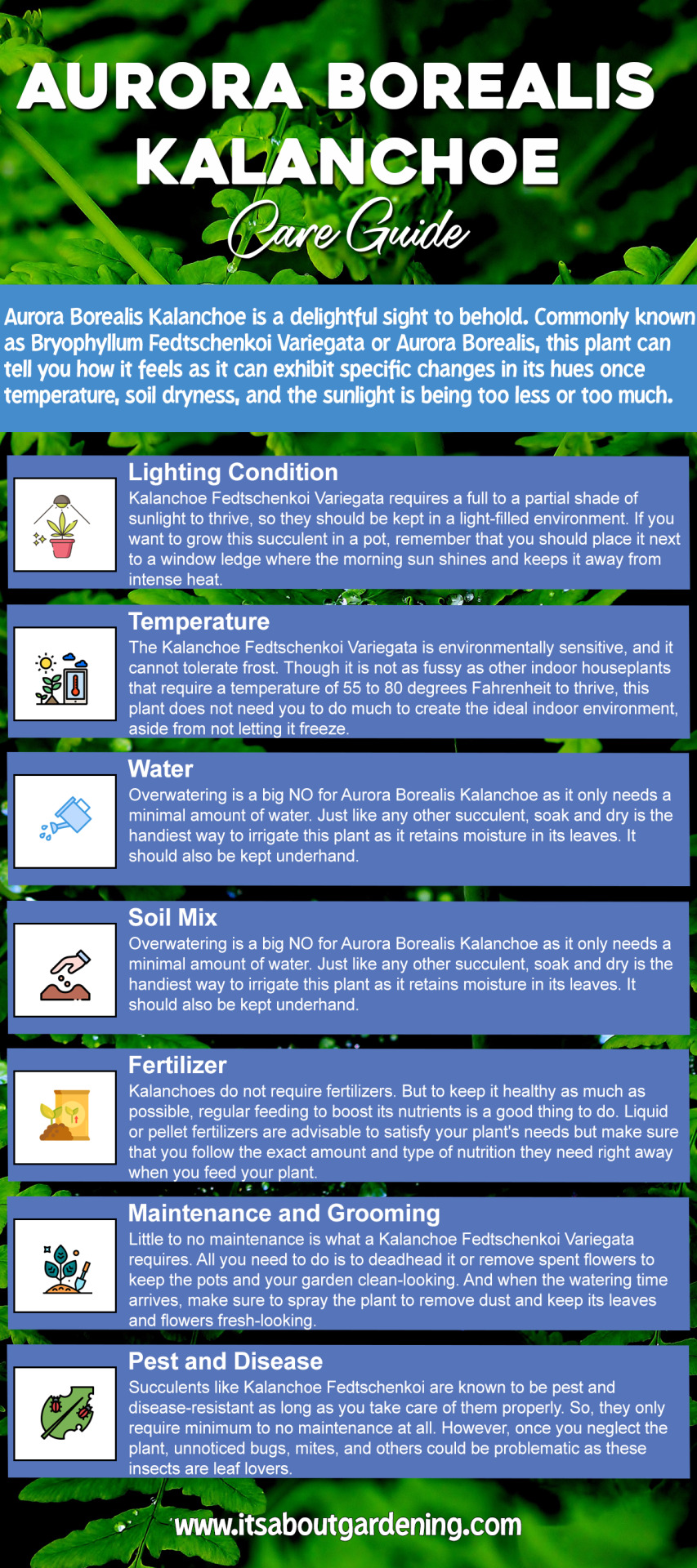
Taxonomic Hierarchy of Aurora BorealisKalanchoe
Kingdom: Plants
Subkingdom: Green Plants
Infrakingdom: Land Plant Kingdoms
Superdivision: Embryophyta
Division: Vascular Plants
Subdivision: Seed Plants
Class: Magnoliopsida
Superorder: Saxifraganae
Order: Saxifragales
Family: Stonecrops
Genus: Bryophyllum
Facts to Know About Aurora Borealis Kalanchoe
Scientific name: Kalanchoe Fedtschenkoi Variegata
Common Name: Aurora Borealis Kalanchoe
Type of Plant: Succulent
Height: 0.50 m.
Width: 0.50 m.
Flower Color: orange.
Blooming Season: early springtime until late winter season
Light: complete to partial shade
Temperature : not frost forgiving
Water: minimal amount
Soil: free-draining, light soil
Fertilizer: fluid or pellet
Propagation: by leaf-cutting
Aurora Borealis Kalanchoe General Care
Kalanchoe Fedtschenkoi Variegata is a slow-growing succulent. Nonetheless, despite having that, it can still be expanded indoors or outdoors, for it is a low-maintenance plant.
Light

Kalanchoe Fedtschenkoi Variegata requires a full to a partial shade of sunshine to prosper, so they must be kept in a light-filled setting.
If you want to expand this succulent in a pot, bear in mind that you should place it alongside a window step where the early morning sun sparkles as well as keeps it far from intense heat. While if you are intending to place it in a garden, make certain it gets lots of sunlight.
Temperature

The Kalanchoe Fedtschenkoi Variegata is ecologically delicate, and also it can not endure frost. Though it is not as fussy as various other indoor houseplants that call for a temperature level of 55 to 80 levels Fahrenheit to prosper, this plant does not require you to do much to develop the perfect indoor setting, aside from not letting it freeze.
While for exterior setups, it requires a temperature level of around 45 degrees Fahrenheit or higher to make it through due to the fact that they are belonging to tropical as well as subtropical environments. Temperatures in between 65 and also 85 levels Fahrenheit on the other hand, are excellent for its growth and flowering.
Water
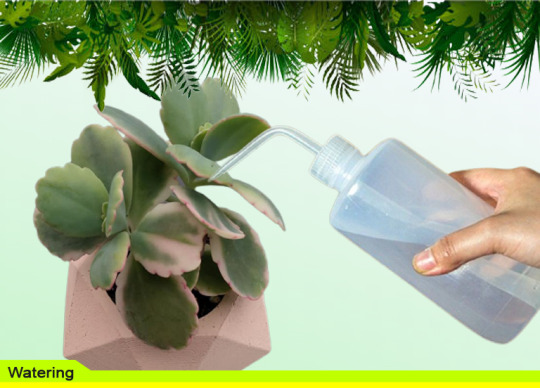
Overwatering is a huge NO for Aurora Borealis Kalanchoe as it only requires a minimal quantity of water. Much like any other succulent, soak and dry is the handiest means to irrigate this plant as it maintains wetness in its fallen leaves. It ought to likewise be maintained underhand.
Soil

Free draining pipes and also light soil is a need to for the Aurora Borealis Kalanchoe to survive. To make certain that the soil you are utilizing is suitable, purchase a cactus or delicious soil that drains pipes well. If you can not find this, you may blend a quantity of 50% sand or perlite into a 50% potting soil/cactus mix. A 60/40 peat moss/perlite mix may likewise suffice to enhance water drain.
In most cases, you should likewise take into consideration the pots you are utilizing. Clay pots are suitable for growing your succulents as this will certainly aid in the wicking of excess water from the soil by helping in guaranteeing correct drain as well as staying clear of overwatering of the plant.
Fertilizer

Kalanchoes do not call for fertilizers. However to keep it healthy and balanced as long as feasible, normal feeding to enhance its nutrients is a good idea to do. Liquid or pellet fertilizers are a good idea to satisfy your plant's needs but make certain that you adhere to the specific amount and kind of nourishment they require as soon as possible when you feed your plant.
Remember, reviewing and complying with the instructions could be of terrific assistance to feed your Kalanchoe Fedtschenkoi Variegata correctly. Mainly Kalanchoes are fed during the springtime and also summer. While in winter, they prevent feeding it as it does not need several nutrients.
Maintenance and Grooming

Little to no maintenance is what a Kalanchoe Fedtschenkoi Variegata requires. All you require to do is to deadhead it or remove spent flowers to keep the pots and also your garden clean-looking.
And also when the watering time gets here, make sure to spray the plant to remove dirt as well as maintain its fallen leaves and blossoms fresh-looking.
Pest and Disease of Aurora Borealis Kalanchoe

Succulents like Kalanchoe Fedtschenkoi are known to be parasite and disease-resistant as long as you look after them properly. So, they only need minimum to no maintenance whatsoever.
However, as soon as you overlook the plant, undetected bugs, mites, as well as others could be troublesome as these insects are leaf fans. So when watering your succulents, better examine it for they may be termites, beetles, or various other insects.
Once a trouble seems to develop, resolve it promptly. Light chemicals are of considerable help, or for critters, scrubing a 70% isopropyl alcohol on the plant parts, utilizing a non-toxic insecticidal spray, or neem oil spray is practical.
Propagation by leaf
If you currently have an Aurora Borealis Kalanchoe delicious, you have seen that it generates offsets, which you can utilize to expand extra plants. The little plants emerge from the moms and dad plant's fallen leave suggestions as well as count on the parent plant for assistance as they grow origins.
To propagate by leaf:.
1. Twist a leaf from the mom plant starts the process.
2. Keep in mind that if a leaf is affixed to the stem, you will have a lower probability of succeeding.
3. Enable the leaf to dry for a few days so completion calluses over.
When there are calluses, plant them in well-draining soil. And also when the planet is entirely completely dry, water it. Take care of it just how you would look after a grown kalanchoe.
#Lighting Condition#Temperature#Watering#Soil Mix#Fertilizer#Maintenance and Grooming#Pest and Disease
0 notes
Text
WATERING GUIDE FOR RAINDROPS ECHEVERIA / Its About Gardening

Recognizing the correct watering overview for Raindrops Echeveria is essential for gardeners to consider since that is where the Raindrops Echeveria's life depends.
The Raindrops Echeveria are well-known for being a drought-tolerant plant and only require low watering. But actually, watering the Raindrops Echeveria will constantly depend on the list below variables:
1. Temperature, Humidity, and Climate

Watering routines ought to transform relying on the location's temperature level, moisture, and also environment where the Raindrops Echeveria will be planted. Having great weather condition implies you require to sprinkle your Raindrops Echeveria much less typically. When it is snowing in your location, the dirt will be wet most of the time, and also you do not need to sprinkle your plant in this situation. In terms of moisture, succulents like Raindrops Echeveria can hold up against completely dry air and also required water to make it through.
2. Seasonal Differences
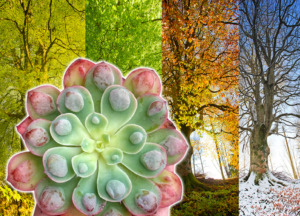
The regularity of watering the Raindrops Echeveria will depend on the period of the year. Probably, if it is summer season, the soil into where you grew the Raindrops Echeveria obtains swiftly dried out. So, two times or three times every ten days would most likely be the moment to water the Raindrops Echeveria. However, ensure that the soil is dry before watering the plant again. On the other hand, if it is winter season, the dirt is a lot more like to be wet the majority of the time, so hardly ever watering is required. Bear in mind not to overwater the soil, or else it might kill the plant. It is also not helpful underwater due to the fact that it will impact the vegetation's development as well as the plant itself.
3.Growing the Raindrops Echeveria Indoor or Outdoor
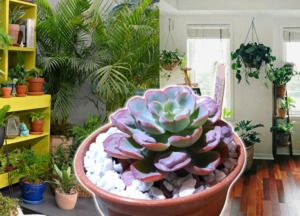
In watering the Raindrops Echeveria, it is also necessary to take into consideration the location or area to grow the Raindrops Echeveria If you will grow Raindrops Echeveria outdoors, the dirt is more likely to dries out quickly. As a result, you can water the Raindrops Echeveria 2 to 3 times every ten days or until the soil dries totally. If, on the other hand, if you put the Raindrops Echeveria inside your home, it only gets marginal sunlight, and the soil will take some time to completely dry. So, you will need to wait up until the soil dries out prior to watering once more.
4. The Size of the Raindrops Echeveria

The dimension of the Raindrops Echeveria is also a factor to think about in watering. The smaller the Raindrops Echeveria is, the less its roots, so it will certainly take time to take in the water from the dirt. And the bigger the Raindrops Echeveria, the even more origins it has to drink water from the soil fastly.
Watering Guide for Raindrops Echeveria
There is also some extra information about the proper watering technique for the Raindrops Echeveria. They are the following:
How much water does Raindrops Echeveria need?
Succulents like the Raindrops Echeveria do not require excessive water yet can not likewise make it through without it. So to make it clear, the Raindrops Echeveria requires just adequate water to grow as well as prosper.
Overwatering
Overwatering the Raindrops Echeveria will certainly damage the plant, or worse, it may eliminate the plant. The Raindrops Echeveria only needs adequate water, so overwatering it will certainly create origin decaying, and if the roots pass away, so will the plant.
How to save overwatered Raindrops Echeveria?
To settle this trouble, you need to repot the plant. The first thing you require to do is meticulously get rid of the Raindrops Echeveria to its previous pot and also get rid of the remaining soil that clings onto the origins. Afterwards, reduced the plant's impacted locations such as the impacted root, stem, or leaves as well as air-dry the staying healthy part of the plant for two days. After two days, prepare a brand-new well-draining pot, mix cacti dirt, as well as include crude or perlite sand. Plant the continuing to be healthy part of the plant into its brand-new residence and also water it after a week.
Underwatering
Underwatering the Raindrops Echeveria will additionally jeopardize the plant, and when we say underwatering, it implies you do not offer sufficient water for the Raindrops Echeveria to expand as well as survive. Succulents like the Raindrops Echeveria are undoubtedly dry spell forgiving, however just like any other plants, it also needs to be sprinkled to live. It is easy to know if your Raindrops Echeveria is underwatered; it will certainly have wrinkled as well as dry vegetation. When you see that your Raindrops Echeveria is having this sort of leaves, it is time for you to make an effort and also save your plant.
How to save underwatered Raindrops Echeveria?
It is straightforward to settle this problem. Just ensure to provide sufficient water to your Raindrops Echeveria however bear in mind not to overwater it. It is better to make use of the "soak and also completely dry" approach, and the underwatered plant will certainly return to its healthy and balanced state within days.
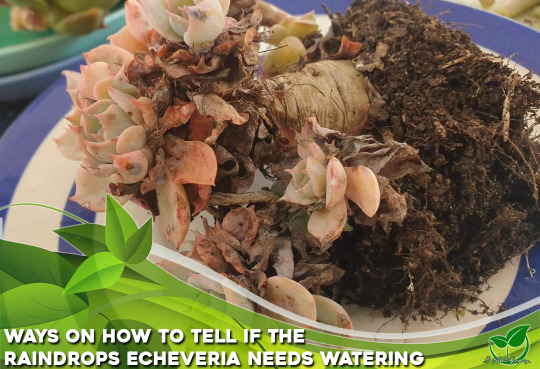
Ways on how to tell if the Raindrops Echeveria needs watering
There are several ways on how to understand if your Raindrops Echeveria needs water. Below are the two most simple means.
Press fingers unto the leaves
Succulents are recognized for having membrane layers on their leaves that shop water that assists the plant to grow in severe drought. In doing this method, press the fallen leaves of the Raindrops Echeveria using your 2 fingers. If the fallen leaves feel shriveled, dry, or limp, it means that it does not have water.
Lifting the succulent up
In doing this approach, very carefully lift the Raindrops Echeveria from its dirt to see if the dirt entirely dries or is still damp. If you saw that the soil is dry, then you require to water it.
What are the watering tools to use?
It is best to make use of a water bottle instead of a spray container in sprinkling the Raindrops Echeveria. Using bottled water stops the Raindrops Echeveria's fallen leaves from splashing.
The main objective of watering is for the origins and soil to get wet as well as not the fallen leaves. Due to the fact that sprinkling the leaves could result in leaf-rotting, which later on will affect the whole plant. If such a situation happened, quickly remove the affected fallen leaves, not to affect their bordering leaves.
One more helpful device that you can utilize is a moisture meter or hygrometers. These tools can inspect the dampness in the soil. Making use of these tools, you can quickly recognize if the dirt is still wet or you require to sprinkle the plant.
Caring for Raindrops Echeveria will be simple as soon as you established a proper watering routine. The info above will assist you recognize the variables you require to think about in sprinkling a succulent such as the Raindrops Echeveria. Remember that every plant, whether delicious or otherwise, requires appropriate watering to expand as well as grow.
#Temperature Humidity and Climate#Seasonal Differences#Growing the Raindrops Echeveria Indoor or Outdoor#The Size of the Raindrops Echeveria
2 notes
·
View notes
Text
HAWORTHIA COOPERI VAR. TRUCNATA CARE GUIDE / Its About Gardening

Haworthia Cooperi Var. Trucnata is a small rosette-forming and stemless houseplant succulent. Haworthia is a huge categories from the Asphodelaceae family members native to Southern Africa.
They are frequently contrasted as well as confused with aloes because they are from the exact same family members. The only difference is that Haworthia is smaller than Aloes.
The common name 'Haworthia' honors the British Botanist and Entomologist Adrian Hardy Haworth.
Haworthia Cooperi Var. Truncata has a fleshy round shape and also thin skin leaves lined with fragile light green blood vessels. Its blue-green translucent fallen leaves come to be copper in shade when subjected to route sunlight and also being drought. Each rosette can produce 20-25 round leaves.
Haworthia is a low-growing delicious and also grows up to 3 inches in size. It blooms from springtime to summer with a straightforward white blossom. It has a single florescence peduncle, regarding 30 cm long.

Haworthia Cooperi Var. Trucnata Care Guide
Haworthia is an excellent plant for newbies due to the fact that they are an easy-care sort of delicious. They are not considered as difficult houseplants to expand.
Below are the lists of vital treatment guides in expanding Haworthia Cooperi Var. Truncata.
Watering Procedure

Just like all succulents, Haworthias are extremely prone to overwatering. They can endure short durations of dry spells and also underwatering.
Never ever enable your Haworthias to sit in water for an extended duration to prevent them from dying. Overwatering is hazardous to any kind of succulents, specifically to Haworthias, due to the fact that they have fleshy leaves as their water storage space. Too much water in the leaves means they can not take the anxiety.
Overwatering can also be the reason to establish molds as well as fungis that brings about root rot. Overwatered succulents can be identified by simply taking a look at their fallen leaves. Suppose the external fallen leaves of the rosette are somehow transforming their shade and appearance, well. In that situation, you can tell there's something incorrect with your Haworthia.
To stop overwatering, you can likewise use the "saturate as well as completely dry" technique. This approach is the process of enabling the dirt to dry entirely prior to sprinkling once again.
If overwatering occurs, do not worry, you can permanently save your cute succulent as long as spotted early. Dig out your Haworthia and inspect how it is significantly harmed. If the origins serve, after that you can just put them or transplant them into new fresh soil. If your Haworthia is severely harmed, cut off the roots, maintain it in a dry and intense area. Allow it completely dry for a week as well as plant it into the brand-new dirt.
Important Reminder:
When you sprinkle your Haworthia, put water right into the dirt just as well as avoid wetting the leaves to prevent sunburn and also rotting.
Soil Requirement

Haworthias don't want way too much moisture. They like to expand in sandy, rocky, and also fast-draining dirt.
When expanded inside your home, use cactus dirt mix, which you can obtain instantly in garden facilities. Create a combination of 30% routine potting soil and 70% perlite, pumice, or crude sand.
If you prepare to move it outdoors, right into the yard grounds, make certain it is well-drained. If required, blend the ground soil with a minimum of 50% of either perlite/pumice or crude sand.
In preparing a medium for your succulents, you need to consider the environment as well as climate they are positioned. If you reside in locations where it hardly gets sun or damp areas, make your medium much more fast-draining than a normal mix. You can apply this process to succulents expanded inside your home because the lighting condition and also ventilation modification.
Lighting Conditions

If you are a delicious enthusiast, you currently recognize that the majority of succulents grow well in full sun. Well, Haworthias are various from various other succulents. They choose to expand in unethical areas. In their natural habitat, they tend to expand under the shrubs and also rock overhangs.
Due to the fact that they expand in the claimed environment, this succulent is excellent and well suited to expand in reduced light conditions indoors, such as houses as well as workplaces.
Situate your potted Haworthia in a bright area with some security to filter the sun from the best ray of the day.
One indicator that your Haworthia is getting too much sunshine, the bluish-green leaves come to be copper in color. And by this, it tells you to relocate your Haworthia to a shadier part of your residence or garden.
However, deep shade for a prolonged period compromises the wellness of your Haworthia. For a busy person, relocating plants every now and then can be a hassle. You might make use of artificial grow light if you do not want relocating plants.
If your Haworthias spent the whole winter season inside, introduce them to brilliant sunlight slowly to prevent sunburn.
Pots

Expanding Haworthias inside your home adorns your home or offices, especially when potted in a lovable pot.
The best pot for Haworthia, especially for Haworthia Cooperi, is a shallow medium-size pot, 3 to four inches in diameter. A shallow medium-size pot is suitable for a low-growing succulent like Haworthia.
Repotting
Haworthia is a slow-growing delicious allowing it to remain in the very same pot for years. Nevertheless, if you intend to keep your Haworthia healthy as well as well, repot your Haworthia every 2 to 3 years to replace the dirt with fresh dirt. Additionally, repot your Haworthias if they have outgrown the pot.
Repotting Haworthia is generally done throughout the autumn season because they are summer-dormant succulents. It is additionally the very best time to eliminate the offsets from their mom plant.
Temperature

Haworthia Cooperi can't endure way too much cold throughout winter months. So, natural area temperature inside throughout winter season is ideal for Haworthias.
Haworthias succeed in temperatures ranging from 75 ° F to 90 ° F. Do not expose your Haworthia to temperature levels lower than 30 ° F.
Toxicity

Typically, Haworthias are non-toxic, yet entering into contact with the sap can cause a rash.
Fertilizer

Since Haworthias are slow-growing succulents, they do not require feeding. However, to attain optimal development, feed your Haworthia during the energetic growing season.
Do not fertilize your Haworthia during the inactivity period, which is in the summer period.
Note: Do not feed freshly potted Haworthia for the very first year.
Pruning
Haworthia does not require pruning. Just get rid of the completely dry leaves from the rosette to maintain its charm.
Dormancy
Haworthia genus is going inactive throughout the height of the summertime. It can endure high heat but slows down the development or remaining in the inactivity duration.
Unlike various other succulents that need more frequent watering during the summertime, Haworthias don't require to water frequently. The dormancy duration lasts for six to 8 weeks.
Propagating Haworthia Cooperi Var. Truncata
You can propagate Haworthia Cooperi Var. Truncata in 2 basic means, via seeds as well as offsets.

Through Seeds
Proliferation through seeds is very easy if you are patient sufficient to wait for your Haworthia to become fully grown.
Prepare a tray or a shallow dish and also filled it with a cactus mix. Lightly water or spray the substrate with water to make it dampness. After that, spread out the Haworthia seed on the substratum as well as cover it with a thin layer of the cactus mix, simply sufficient to cover the seeds.
Keep the tray in a warm and also intense location but do not reveal it to route
Through Offsets
The easiest method to propagate Haworthia is through offsets. Haworthias, like various other succulents, produce offsets with time. These offsets or pups can be duplicated and also make brand-new plants.
When propagating Haworthias with offsets, remove the mother plant revealing the origins to check the dogs you will certainly use in proliferation. Meticulously cut off the offsets from the mom plant, including their origins.
After eliminating the offsets from the mommy plant, move them right into their brand-new pot filled with a cactus mix. Do not sprinkle them instantly. Gently haze the dirt of the infant Haworthias occasionally as well as back to routine watering till it is totally established.
An additional point, if you cut the balanced out without origins, let it completely dry for concerning 2-3 days up until it unsympathetic prior to growing it right into the soil.
Haworthia Cooperi Var. Truncata Pest and Problems

Unlike other succulents, Haworthia Cooperi is usually devoid of pests. Yet one of the most typical issue in expanding Haworthia Cooperi, specifically if you live in tropical climates, is the bacteria called Erwinia carotovora.
Erwinia carotovora is a plant virus belonging to the family members Enterobacteriaceae. It is a gram-negative, rod-shaped germs caused by bacteria entering wounds or natural openings of the plant.
Injuries can be from insect damage, pet damage, inadvertently knocking the plant with gardening devices, etc. On cactus plants, it will take at the very least a week for an injury to scab over, depending, certainly, on the dimension of the damage.
There is no remedy for this illness. The most effective method to manage this microorganisms is to take safety nets to avoid it-- regular cleaning of gardening tools and sanitizing in between each usage.
#Watering Procedure#Soil Requirement#Lightning Condition#Pots#Temperature#Toxicity#Fertilizer#Propagation#Pest
0 notes
Text
BEST SOIL FOR CACTUS: WHAT TYPE OF SOIL IS BEST FOR CACTUS? / Its About Gardening

Behind every healthy and balanced cactus lies well-conditioned dirt. It is of utmost relevance to pick the most effective dirt for cactus because it assists the plant grow well, produce an attractive flower, maintain its spiny structure, as well as maintain its enticing types.
Cactus as a houseplant usually needs dirt that closely resembles its all-natural habitat-- the desert.
Therefore, the adhering to info will be your guide in selecting as well as developing the most effective soil for cactus for them to have a lengthy life expectancy:
Best Soil for Cactus; Its Characteristics

Understanding the most effective dirt qualities for cactus is necessary since it will certainly act as your leading guide to select the ideal soil as well as which kind you ought to not utilize.
Well-draining
The soil ought to be well-draining because it typically expands in an arid setting. This kind of soil aids eliminate the excess water so that it will certainly not cause origin rot.
Pebbly and Sandy
Given that it is a desertic plant, for that reason, the most effective dirt for cactus must be pebbly as well as sandy in a practical quantity. Cactus tends to expand well in this type of dirt that dries out quickly. Furthermore, stones assist to boost drainage that sustains the excess water to relocate easily.
Porous
The soil's pores aid maintain the nutrients and also keep the sufficient quantity of water needed by the origins as well as the cactus. It is essential to keep in mind that the best soil for cactus is additionally a permeable one if you want a heartier plant growth.
The Right pH Levels
The dirt reaction's pH shows the loved one level of acidity (sour) or alkalinity (pleasant) of the soil. With that, the most effective soil for cactus should remain in the pH variety of 5 to 6.
In many cases, it could result in the death of the cactus when the pH of the dirt you utilized is listed below 4 as well as higher than the pH series of 7 to 7.5.
One suggestion for maintaining the balance of the dirt pH is to make use of rain. On the other hand, you can utilize a commercial test probe or pH examination strips to examine your soil mix if it has the appropriate pH.
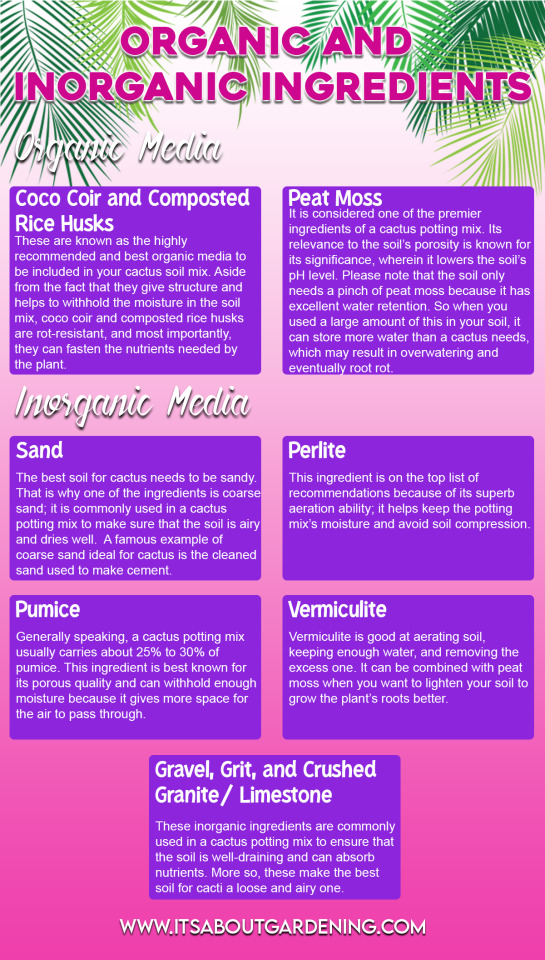
Organic and Inorganic Ingredients
The complying with are some natural and not natural ingredients in nature that will certainly assist you create the very best soil for cactus.
1. Organic Media

Coco Coir and Composted Rice Husks
These are called the highly advised and best organic media to be consisted of in your cactus dirt mix.
Aside from the reality that they provide structure as well as helps to keep the moisture in the soil mix, coco coir and also composted rice husks are rot-resistant, and also most notably, they can fasten the nutrients needed by the plant.
Peat Moss
It is thought about one of the premier components of a cactus potting mix. Its relevance to the dirt's porosity is known for its value, where it lowers the dirt's pH degree.
Please note that the dirt just requires a pinch of peat moss since it has outstanding water retention.
So when you made use of a huge amount of this in your dirt, it can keep much more water than a cactus needs, which might result in overwatering and ultimately root rot.
2. Inorganic Media

Sand
The very best soil for cactus needs to be sandy. That is why one of the active ingredients is crude sand; it is typically used in a cactus potting mix to see to it that the dirt is ventilated and dries well.
A famous instance of crude sand suitable for cactus is the cleansed sand made use of to make concrete.
Perlite
This active ingredient is on the top checklist of referrals due to its superb aeration capacity; it assists keep the potting mix's wetness as well as stay clear of dirt compression.
Pumice
Generally speaking, a cactus potting mix typically carries concerning 25% to 30% of pumice. This component is best recognized for its permeable top quality and can keep sufficient dampness since it provides more area for the air to go through.
It helps the water run efficiently through the soil, and this volcanic rock has micronutrients that are beneficial to the plant.
Vermiculite
Vermiculite is efficient freshening dirt, keeping sufficient water, and also removing the excess one. It can be combined with peat moss when you wish to lighten your dirt to expand the plant's origins better.
Moreover, it is made use of for healthier plant development due to the fact that it enables the plants to absorb potassium, calcium, ammonium, as well as magnesium.
Gravel, Grit, and Crushed Granite/ Limestone
These inorganic active ingredients are generally made use of in a cactus potting mix to make sure that the soil is well-draining as well as can soak up nutrients.
More so, these make the most effective soil for cacti a loosened and ventilated one.
What if you want to make use of a commercial soil mix?

If you do not have adequate time to produce a cactus potting mix, one more alternative is to purchase business cactus potting dirt, but it is crucial to ensure that it is the most effective soil for your cacti.
Constantly bear in mind the following when choosing a commercial potting soil for your cactus:
Please note that advertised potting soil is not that adequate for your interior cactus plant. A treatment for this is to integrate it with pumice or other organic/ not natural media to accomplish the soil's suitable porosity as well as boost its mineral material.
Select the cactus potting mix that is a well-draining one as well as has fantastic water-storing top quality to maintain the soil's wetness.
Reminder in making your cactus soil mix
It would certainly be a whole lot more affordable when you make your cactus potting mix, yet it does require effort and also time. There is no solitary dish for a cactus potting mix, the one required by a desert cactus varies from what soil mix is required by a forest cactus.
You should prevent making use of manure in your soil mix because it tends to generate a fungi that can harm the cactus's origins.
For plants, water has the exact same relevance as dirt. Choosing the very best dirt for cactus helps the plant to thrive best. That is why the ideas stated above will certainly be valuable for you as a plant lover.
Constantly guarantee to choose the dirt potting mix suitable for your cactus for a heartier growth rich in nutrients, well-draining, porous, pebbly, sandy, with the appropriate pH degree, as well as uses natural or inorganic media.
0 notes
Text
CRASSULA HUMMEL’S SUNSET SUCCULENT CARE / Its About Gardening

Crassula Hummel's Sunset is one of the several ranges of Crassula Ovata or Jade Plant. It is also typically known as the Golden Jade, specified in the Crassula category in the Crassulaceae family members.
The name Crassula Hummel's Sundown originated from its Hybridizer and also its sunset-like shade.
Emerald Edward Hummel (1903-1979), a popular Nurseryman as well as Plantsman and kept in mind Horticultural Experimenter and delicious Hybridizer, presented Crassula Hummel's Sundown.
In 1993, Hummel's Sundown won the prestigious Honor of Garden Value of the Royal Horticultural Society.
Hummel's Sunset is an evergreen delicious subshrub with glossy tiny egg-shaped environment-friendly fallen leaves tipped with gold yellow and also vivid red sides. It grows up to 1-3 ft. high and 1-2 ft. wide if grown outdoors on premises.
This acclaimed succulent is well known to bring Goodluck to individuals that are maintaining this plant. Individuals usually keep them growing inside in a gorgeous plant pot, consistently pruned, and also expanded as bonsai.
Hummel's Sunset generates clusters of white star-shaped flowers throughout winter season.

Crassula Hummel's Sunset Care Guide
Crassula Ovata or Jade plants usually are pretty very easy to grow. They don't need much effort and time to make them healthy and balanced and attractive. There are several factors to think about in cultivating Hummel's Sundown. Discovering the essential treatment overview in establishing Hummel's Sundown will certainly assist you establish a healthy and balanced succulent.
Watering Procedure

Every plant requires a different treatment of watering. You need to take into consideration the kind of plant as well as where you stay in administering water for every plant.
Hummel's Sunset, just like various other succulents, requires modest watering for succulents. They don't require regular watering as they are at risk to overwatering.
If expanded inside your home, Hummel's Sunset's dirt will not swiftly completely dry since it has a various atmosphere from the ones outdoors.
When watering Hummel's Sunset, utilize the 'Soak and Dry' technique to avoid overwatering. Ensure that the dirt is dry before watering again. Do not water your succulents if you discover that the tool is damp.
It is better to underwater your Hummel's Sunset than to overwater because Jade plants are understood to have fleshy fallen leaves and stems that function as their water storage so they can grow in short durations of drought.
You can constantly tell if your Jade needs rehydration by just checking out their leaves. If you notice the leaves of your Jade start to wrinkle, it is time to water it deeply.
Additionally, constantly take into consideration the periods in watering your succulents. Throughout the Summer as well as Springtime seasons, succulents require constant watering than the fall and winter seasons.
Soil Requirement

hoosing the tool that you will make use of is also critical in growing Hummel's Sundown The watering regularity also depends upon the dirt utilized. So make certain that you are making use of the proper dirt type for your Jade.
As you all know, many succulents expand in arid regions and rocky places. To keep them healthy, you require to give the same conditions as the initial atmosphere. Meaning, you need to create an environment similar to their all-natural environment.
Jade Plants like Hummel's Sunset need well-drained dirt. This type of combination permits water to drain because, as we know, succulents don't like to sit in wetness for long. It likewise offers proper oygenation to the origins of your plants. Without sufficient aeration creates the origins rot as a result of waterlogging
Lighting Conditions for Crassula Hummel's Sunset

Hummel's Sunset is typically maintained indoors as an accessory and since many people think that it brings Goodluck. Nonetheless, this plant can flourish well both indoors as well as outdoors.
If maintained indoors, place your Hummel's Sundown in an area where they can get a great deal of light. Position your Hummel's Sunset near home windows or home window sill to get sufficient sunlight.
Keeping them outdoors, with full sun to partial shade, will certainly obtain its ideal fallen leave coloration. They maintain growing well if you give them a minimum of 4-6 hours of direct sunshine in the morning.
Throughout the summer months, be sure to safeguard your Hummel's Sunset from the intense heat of the afternoon sun to avoid sunburn.
Pots and Repotting of Crassula Hummel's Sunset
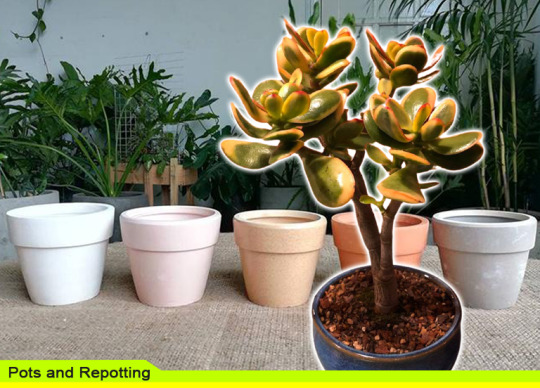
If you reside in chillier climates, Jade plants like Hummel's Sundown are normally expanded in containers indoors because they are not cold-hardy. When expanding Hummel's Sundown in containers, it is essential to have great drain similar to various other succulents.
Jade plants or succulents normally are vulnerable to overwatering, so always consider ideal pots for your Jade plants. Using terracotta and also ceramic pots is perfect for expanding Hummel's Sunset.
Hummel's Sundown can mature to 3 feet high and 2 feet large when expanded on premises. If grown in containers, Hummel's Sundown will stay tiny and cultivated as a bonsai tree. Jade plants are top-heavy, so choose a hefty planter to prevent them from tipping.
Temperature

Hummel's Sunset is not cold-hardy. During the summertime, Hummel's Sundown can grow in a perfect temperature ranging from 65ºF/ 18ºC to 70ºF/ 21ºC. In winter season, it can endure temperatures as reduced as 50ºF/ 10ºC.
If you can't bring your Jade plant indoors throughout chilly months, you can use a tiny greenhouse to cover them to protect them from frost.
Toxicity

Crassula Hummels's Sundown can be hazardous to humans as well as pets when ingested. If you have animals or youngsters in your house, maintain them far from this type of plant.
A pleasant suggestion: Always clean your hands after gardening to prevent skin irritation or, worse, poisoning.
Fertilizer

Hummel's Sunset can grow well without feeding. Nevertheless, if you desire your Jade plant to expand healthier, you can feed them with a balanced blend of plant food thinned down to half stamina every 2 weeks of the growing season.
Feeding likewise motivates your Hummel's Sundown to bloom.
Pruning
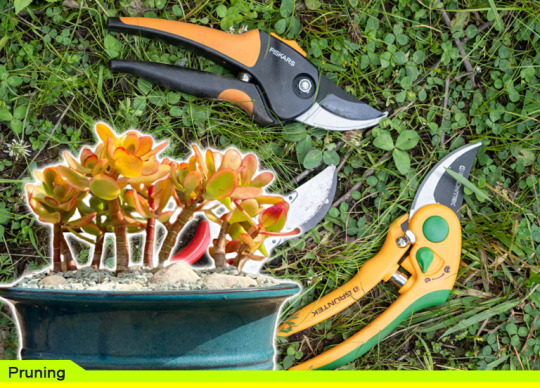
The majority of garden enthusiasts trim their Jades not just for health and wellness yet also for aesthetic factors. Trimming can be critical as this will certainly reveal the plants to potential bacterial damages, which can cause the plant to expand weak and at some point die.
Prior to trimming, take into consideration the opportunities that can happen to your Jade. Make note: Prunning is for developed Jade plants only.
When trimming, check initially which part of the plant requires to get rid of. Take a clean set of trimming shears and cut off the branches or stems you selected. Trim the stems a minimum of to the closest node.
Propagating Crassula Hummel's Sunset

Crassula Ovata Hummel's Sunset is a superb enhancement to your delicious collection and can additionally be an accent item in your workplace or residence. It is likewise a terrific idea to share it with your families and friends as presents.
You can grow your collection of Jades without investing much. Instead of getting new plants, why not consider proliferating. While it is a challenging task, it can likewise expand your understanding regarding growing succulents.
Jade plant ranges are just one of the most convenient plants to propagate.
Through leaves
In proliferating Hummel's Sundown via leaf cuttings, make certain it is a healthy and balanced brand-new fallen leave for a much better success price. The leaves will start to develop new origins in regarding 2 weeks. New infant plants will start to expand after a few even more weeks depending on your climate conditions.
Through Stem Cutting
The easiest way to circulate Jade is through stem cutting since it has a higher success rate. Utilize a clean blade or pruning shears to cut a little area of a healthy and balanced stem. Allow the cuttings to dry out for few days. Some people use rooting hormonal agents to accelerate the procedure. Put the cut stem right into its brand-new pot with well-draining dirt and position them in partial color. Water lightly until origins develop in a couple of weeks.
Crassula Hummel's Sunset Pest and Problems

Prior to buying or bringing plants right into your house, constantly examine it and also the container for indicators of bugs. It is best to move your plant to a new pot to examine the soil as well as inspect the roots extensively.
Always bear in mind not to put your recently purchased plants near your other plants. To be added safe, you can quarantine your fresh bought plants for a month before joining them with others.
Sadly, Hummel's Sundown is at risk to insects as well as bugs. Otherwise dealt with early, it will certainly pass away. Always check your Hummel's Sunset whenever you water them to stop troubles from spreading.
In growing succulents, there are couple of typical pests known to be damaging to your beautiful plants.
Mealybugs
Mealybugs are seriously lethal to succulents otherwise dealt with early. They drew the dampness from the plants, causing wrinkly fallen leaves, and at some point dried up your Hummel's Sundown.
Mealybugs are tiny white soft-bodied insects and also appear with tiny, white, cottony, weblike compound. Often you might not see those tiny pests since they hide in the crevices of the fallen leaves.
It is less complicated to get rid of the plant if the infestation is too hefty. If light problems, pick off mealybugs with cotton suggestions dipped in alcohol.
An additional option is an organic spray, yet make sure to scrape off any wax as well as pests, which additionally works as included protection.
Aphids
Aphids are small sap-sucking bugs in the superfamily Aphodoidea. They typically feed in collections on brand-new plant growth.
Ants and aphids can form equally beneficial partnerships that make invasions also worse. Ants protect aphids from predators in return for honeydew secretions.
You can deal with aphid infestations with a solid jet of water to get rid of the bugs from the plants. You can also make use of a light soap mixture sprayed on the plant.
In growing Crassula Hummel's Sunset, just like other succulents, you may come across a couple of common issues.
One of the most common issue that you can experience is overwatering. If the fallen leaves of your Hummel's beginning to look undesirable and mushy, it is a sign of an overwatered plant.
Enable the plant to dry out totally and also cut back the watering. If the soil is not fast-drying sufficient, take into consideration changing the medium with more well-draining soil.
One more trouble that you may experience is the browning of the leaves, which suggests sunburn. Take into consideration relocating your Hummel's Sundown into the shader part of your garden or inside throughout the summer season. Extreme heat from the mid-day sun could also shed the fallen leaves of your succulents.
If expanded on grounds and can not bring inside your home, cover them with a cloth to avoid sunburn.
If you are a busy person as well as failed to remember to sprinkle your Hummel's Sunset, expect the plant's delegates be perished as well as wrinkled. Withered fallen leaves could be an indicator that your plant is underwatered and needs a good beverage. Promptly soak your plant extensively to maintain them hydrated. After couple of hours or so, the leaves will certainly begin to cheer up.
Always bear in mind that underwatering is as fatal as overwatering.
#Watering Procedure#Soil Requirement#Lighting Conditions#Pots and Repotting#Temperature#Toxicity#Fertilizer#Pruning#Propagation#Pest and Problems
0 notes
Text
DIFFERENT TYPES OF HAWORTHIA SUCCULENTS / Its About Gardening

Different Types Of Haworthia-- Haworthia is a big genus of succulents that are little in size as well as are slow-growing plants. It boggles the mind that these succulents feature various leaf forms, flower sizes, shades, and hardiness zone.
If you ask yourself where this delicious kind gets its name from, it was after the British botanist and also entomologist Adrian Hardy Haworth. These sorts of succulents are understood to be container or yard plants. And like any other succulents, they also generate unique flowers during their growing seasons. Those blossoms are usually white in shade and also tiny in dimension.

Different Types Of Haworthia Succulent
Did you understand how many varieties are under this type of plant? Well, there are about 150 varieties of them. Isn't it amazing? The majority of these succulents are singular, and some are clump-forming. You can additionally check out listed below a few of the different sorts of Haworthia succulents.
1. Haworthia Coarctata

Haworthia Coarctata or Haworthiopsis Coarctata is a delicious native from South Africa. It is a slow-growing and also clump-forming succulent that has amazing attributes. Haworthia coarctata has dark-green rosettes with pink and bent ideas.
This succulent is not cold-hardy as well as can tolerate Zone 10a (minimum 30 0F -1.1 0C). It is also a dormant summer sort of delicious however still prefers partial shade to complete sunlight. When this delicious grows, anticipate that it can get to 8 inches in height and also 2 inches broad.
You can multiply Haworthia Coarctata by its offsets, seeds, or leaves. It is very easy to care succulent and just calls for normal watering.
2. Haworthia Margaritifera

This succulent is recognized for numerous names: Haworthia Pumila or Pearl plant, Cushion Aloe, as well as Fasciata Zebra cactus plant. With its distinct and lovable look, it is remarkably a low-maintenance plant.
When this delicious grows, it can rise to 4 inches in height as well as 6 inches vast. When its rosettes expand, you can anticipate that they grow in globs. The fallen leaves of Haworthia Margaritifera have a tendency to expand upward in a curving position.
Like any other succulents, the blooming season of this plant is throughout springtime. And when it blooms, it produces slim blossom stalks. One more piece of information regarding this succulent is that it can prosper in partial shade to full sunlight.
Still, it can not withstand listed below 53o degrees Fahrenheit. A fascinating truth about Haworthia Margaritifera is it can measure up to thirty years! Isn't it impressive?
3. Haworthia Venosa

This succulent is belonging to the Southern part of Africa and Namibia. It has various other names, such as Haworthia Tessellata, but a lot of Africans called it Venstertjie. This plant is not like any other plant since it is adaptable to both great and also warm places.
Though Haworthia Venosa still prefers low humidity with tool light and not straight sunshine. It can still survive throughout winter season with 15 0C or 59 0F temperature. Lots of gardeners and succulent collection agencies enjoy this plant because of its lovely fallen leave markings as well as shade.
When correctly looked after, Haworthia Venosa can grow up to 5 inches in elevation. And during the summertime season, you can expect some tiny and also white-colored blossoms on the top of its stem. It is also great to recognize that this succulent is non-toxic to people and animals, so it is risk-free to have this plant anywhere you want.
4. Haworthia Attenuata
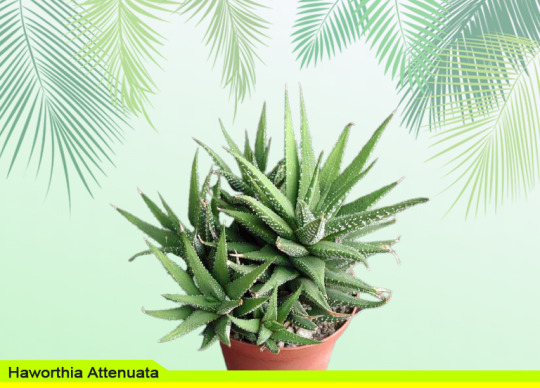
Haworthia attenuata is generally misinterpreted for Haworthia fasciata. Both of these succulents have an one-of-a-kind attribute: zebra red stripes that surround each leaf of the plants.
However, Haworthia attenuata has deserving developments and also thick leaves than Haworthia fasciata. The rosettes of Haworthia attenuata can mature to 8 inches high as well as 5 inches wide, as well as these rosettes come in clumps.
Throughout the summer season, which is its growing time, this succulent produces small pink or white flowers on the top end of the stem. Haworthia Attenuata's expanding period is from April to September. And this delicious loves brilliant sun, so when placed inside, it rarely flowers.
5. Haworthia Fasciata

The name of this delicious came from the Latin word "fascia," which indicates "band or strip." Because of those white red stripes around its fallen leaves, it is likewise called Zebra Haworthia.
You can find this plant in the Southern part of Africa. Apart from its one-of-a-kind lines, it has dark-green leaves, thick and also triangular. Despite the fact that Haworthia fasciata is a fairly little succulent and can just grow for about 5 inches, it still generates flowers.
These white-colored flowers appear in springtime or summertime. This delicious is also not chilly durable and loves intense sunlight, but it still can grow well indoors. Aside from that, it is also dry spell forgiving and also summer season dormant. Haworthia fasciata is secure to have around given that it is safe to humans and pets. It is certainly real that Haworthia fasciata is an uncommon plant.
6. Haworthia Cuspidata

The name "Cuspidata" originated from the Latin word "cupidatus," which indicates "pointed." It has a scientific name of Haworthia Cymbiformis, however this delicious is widely prominent as Star window Plant.
Haworthia cuspidata is recognized for having uncommon rosettes such as pointed pointers and also grey-green obovate leaves. These rosettes can grow up to 4 inches in size. Although Haworthia cuspidata is a stemless plant, it can still produce flowers.
Some white-colored flowers show up in florescence in late springtime or mid-summer, which includes charm to the plant. For this plant to accomplish its best look, it needs partial color to full sunlight.
It will certainly take some time before Haworthia Cuspidata becomes a mature succulent given that it belongs to the slow-growing sort of succulents.
7. Haworthia Truncata

If a word can define this succulent, that word is unusually stunning. Haworthia Truncata is an uncommon plant and also hails Cape Province, South Africa.
This delicious is understood for having fallen leaves that resemble a steed's teeth. These leaves expand in thick clusters for regarding 3 to 5 inches in elevation. The small leaves are green in color and rectangle-shaped in shape. This type of succulent forms florescence stalks where white flowers appear in summertime.
Haworthia Truncata is an easy to care plant that just needs normal watering and partial color to full sunlight. It is versatile to temperature adjustments and also can stand up to light frost but not less than 41 0F.
8. Haworthia Springbokvlakensis

This delicious is not a typical kind of plant. It has unique functions such as brown red stripes on its clear, gray-green fallen leaves.
Other than that, Haworthia Springbokvlakensis's foliage has rounded leaf pointers, that makes it extra cute.
Those leaves can grow up to 2 to 3 inches in height as well as 0.6 large. This type of delicious is generally little and slow-growing. In summertime, it creates attractive white flowers. Many garden enthusiasts enjoy this plant due to the fact that it is simple to look after and also not challenging to expand.
9. Haworthia Bolusii
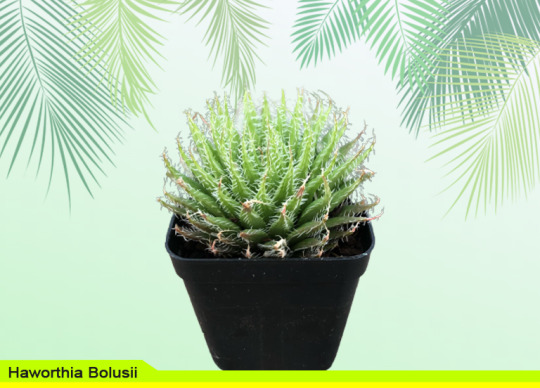
This stemless delicious can grow up to 6 inches in elevation. It has fleshy environment-friendly fallen leaves that can mature to 3.2 inches large. Haworthia Bolusii's vegetation is incurved in shape as well as extends inwardly in a curved instructions.
When you look more detailed, this delicious has clear thorns on its margins, and from afar, those thorns look like a crawler web. In late spring to early summer season, Haworthia Bolusii produces tiny white flowers with brown veins.
For this succulent to grow, it needs a cozy temperature in summer as well as an amazing temperature in wintertime. Too much cold and heat may damage this plant.
10. Haworthia Angustifolia

Haworthia Angustifolia gets its name from the Latin words "Angus," which suggests "slim," as well as "folium," which means "fallen leave." That is why it is likewise called Narrow-leaved Haworthia.
This plant is native to South Africa, as well as unlike most Haworthia's, Haworthia Angustifolia is a fast-growing succulent. The only resemblance of this succulent to others is its elevation. Haworthia Angustifolia is reasonably small and also can only mature to 3.2 inches in size and also 4 inches in height.
Its rosette is composed of soft, slim, as well as fleshy-green leaves that grow in an upright direction. In spring, this plant produces white blossoms that expand in inflorescence. It additionally favors partial shade as opposed to complete sunlight.
11. Haworthia Chloracantha

This succulent is a renowned garden or container plant. It has yellow-green leaves and a red center that expands in globs. Each rosette has 18-25 fallen leaves which can grow up to 1.6 inches long.
It is a low-maintenance plant that can thrive in partial shade as well as just calls for really little as well as seldom watering. Haworthia Chloracantha is additionally frost-hardy and also can survive in an area with a temperature of -5 oC.
The best month to grow this delicious remains in March, when it is proactively expanding. As well as its flowering time remains in summertime, where it creates tiny white flowers.
12. Haworthia Reinwardtii

Haworthia Reinwardtii is a tiny clump-forming succulent known as African Pearls. The fallen leaves at the end of the plant are significant, and there are visibly little white warts at the rear of each leaf that are rough in appearance.
This plant can grow up to 8 inches in elevation, and you can propagate it in seeds or offsets. Haworthia reinwardtii is not cool sturdy as well as prefers warmer temperature levels to expand magnificently. It generates white blossoms in spring and also is relatively non-toxic to humans as well as pet dogs.
13. Haworthia Viscosa

This delicious is among the one-of-a-kind types of Haworthia. It has actually extended rosettes loaded with three-column triangular fallen leaves.<br>
Each fallen leave can reach 1.6 inches in height as well as has a green to red color. Haworthia Viscosa is also frost durable delicious and can stand up to -5 0C. This delicious generates white to pinkish blossoms that appear in inflorescence.
It is best to plant this delicious in March when it is growing period and also place it in partial color to accomplish its finest color.
14. Haworthia Nigra

Haworthia Nigra is additionally called Black Haworthia and is belonging to South Africa. It has rosettes that can grow up to 10 cm high as well as 6 centimeters wide.
It has noticeable dark green to almost black colored leaves that expand in 3 columns as well as is triangular. Haworthia Nigra is a slow-growing yet low-maintenance plant. It does not require much initiative to develop this delicious.
It can grow as long as you offer partial shade and also very little watering. Like any other Haworthias, Haworthia Nigra additionally creates white blossoms in spring. This plant is non-toxic to people and also pet dogs, so it is risk-free to have it around.
15. Haworthia Emelyae

Haworthia Emelyae or Haworthia Picta is a small succulent that grows fleshy environment-friendly fallen leaves in a triangular form. Each leaf has white lines that appear like veins. Haworthia emelyae can mature to 5 inches tall. In spring, it generates white flowers that are reasonably tiny as well as scentless.
16. Haworthia Bayeri

This delicious is likewise called "Moon Darkness." It is slow-growing yet among the most loved kinds of Hawothias as a result of its undoubtedly gorgeous markings.
Haworthia bayeri has dark-colored leaves with rounded suggestions. From springtime to summer season, this plant creates whitish-green blossoms.
It is a low-maintenance plant, so there is no requirement to invest great deals of cash. Haworthia bayeri is likewise versatile to different temperatures however still chooses cozy temperature levels in summer season and also cool in winter season.
17. Haworthia Cooperi Picturata
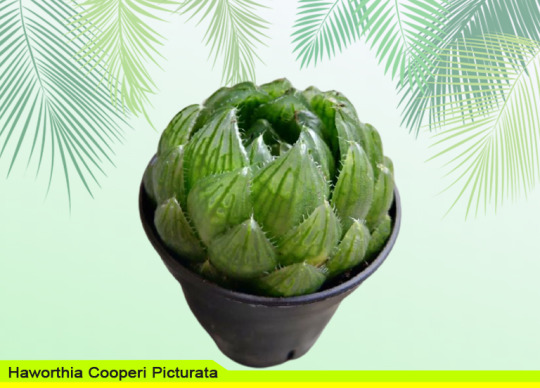
Haworthia Cooperi Picturata is a little stemless delicious. It has yellow-green fallen leaves that expand in a curved inner instructions which forms globs.
Each leaf has eco-friendly cellular linings, pointed pointers, and also little white thorns. Haworthia Cooperi Picturata produces pinkish-white flowers from springtime to summer season. This type of Haworthia is an essential delicious, as well as it is a great indoor or outside plant.
18. Haworthia Hybrid Cooperi var. Venusta x Chocolate
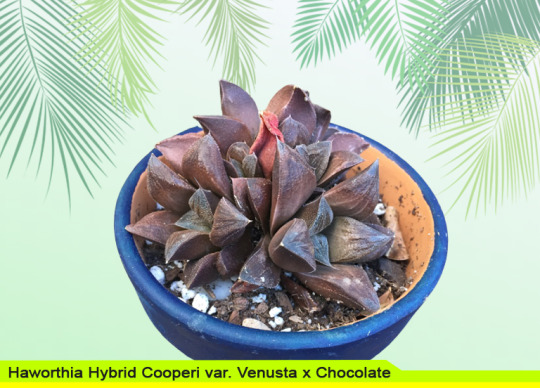
This kind of Haworthia is a hybrid with impressive reddish-brown colored leaves. Its leaves are thick as well as harsh as well as have a triangular shape.
When mature, this delicious can reach 5 inches tall-- Haworthia Crossbreed Cooperi var. Venusta x Delicious Chocolate or Haworthia Delicious chocolate favors partial color to complete sun. It is likewise drought-tolerant to ensure that it can flourish without water for weeks or months.
19. Haworthia Koelmaniorum
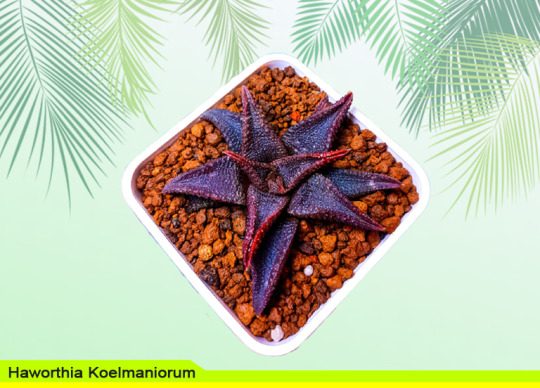
Haworthia Koelmaniorum is a type of Haworthia that is native to the North part of South Africa. It is a delicious that changes color gradually, from brown environment-friendly to reddish color. Its fallen leaves are harsh and also thick.
In summer, this Haworthia generates white flowers. Bright light is needed for this plant to attain its natural shade and thrive. Unlike other Haworthias, Haworthia Koelmaniorum hardly ever has an offset.
20. Haworthia Transiens

Haworthia Transiens is a stemless plant that has fleshy light green foliage. Its leaves are rather rounded with sharp red ideas. Despite the fact that this kind of Haworthia is a great interior or outside plant, it can just mature to 2 inches tall given that it is a relatively tiny succulent.
The 20 noted different sorts of Haworthia succulents above are only several of the must-haves. Haworthias are simple to take care of, and you can pick from a wide variety of choices. They might all look comparable in dimension, yet their special functions are various from one another. It is really difficult to stand up to the appeal of this kind of plant. It is also great to recognize that Haworthias are understood for being human and pet-friendly and also low-maintenance home plants.
0 notes